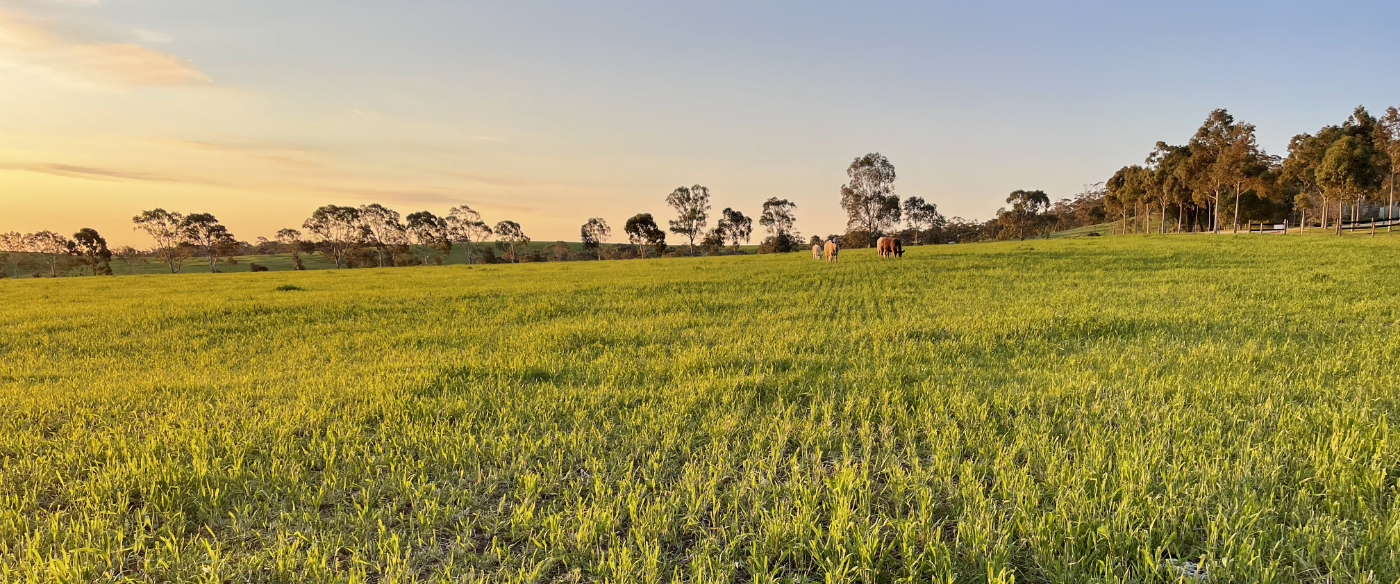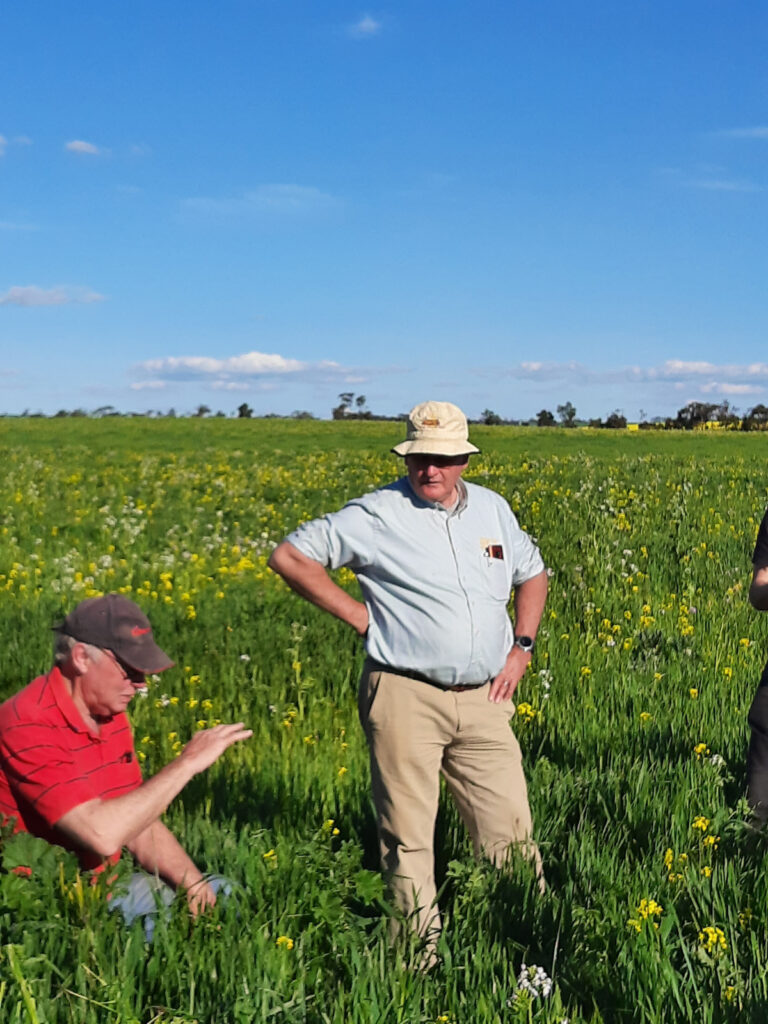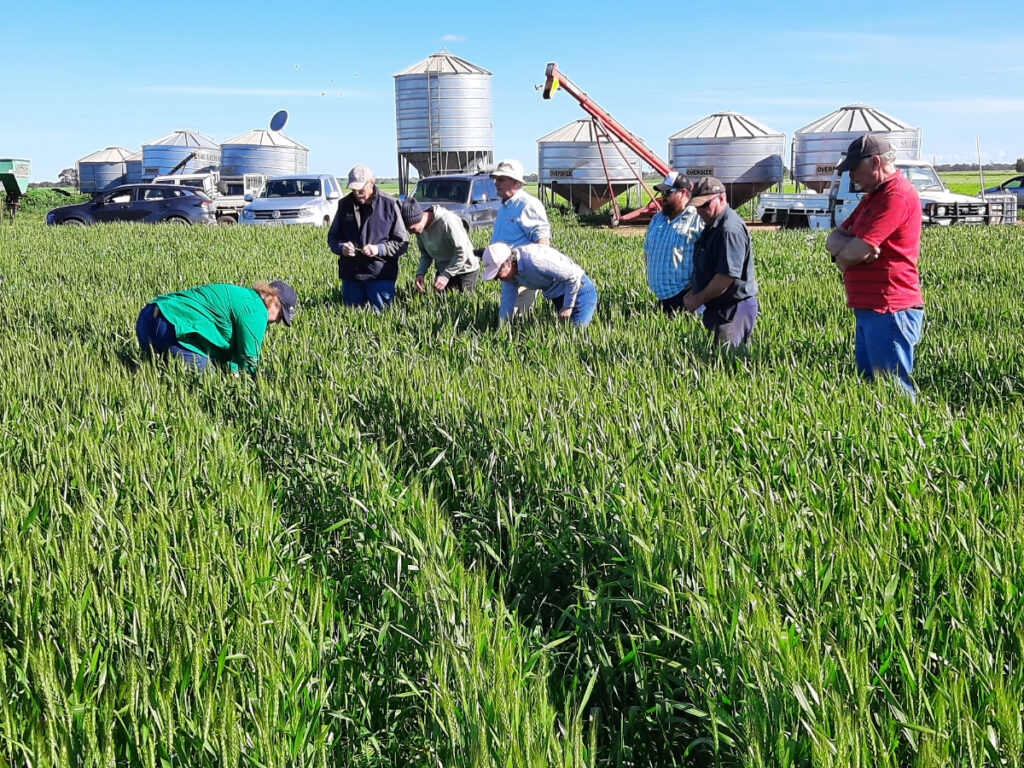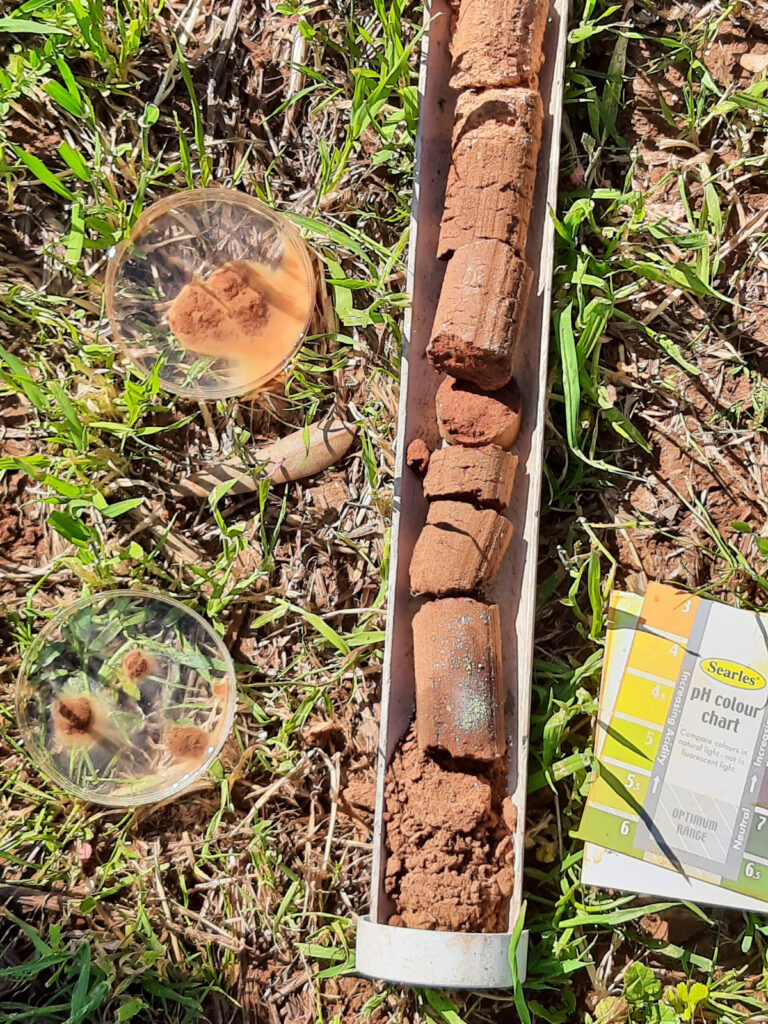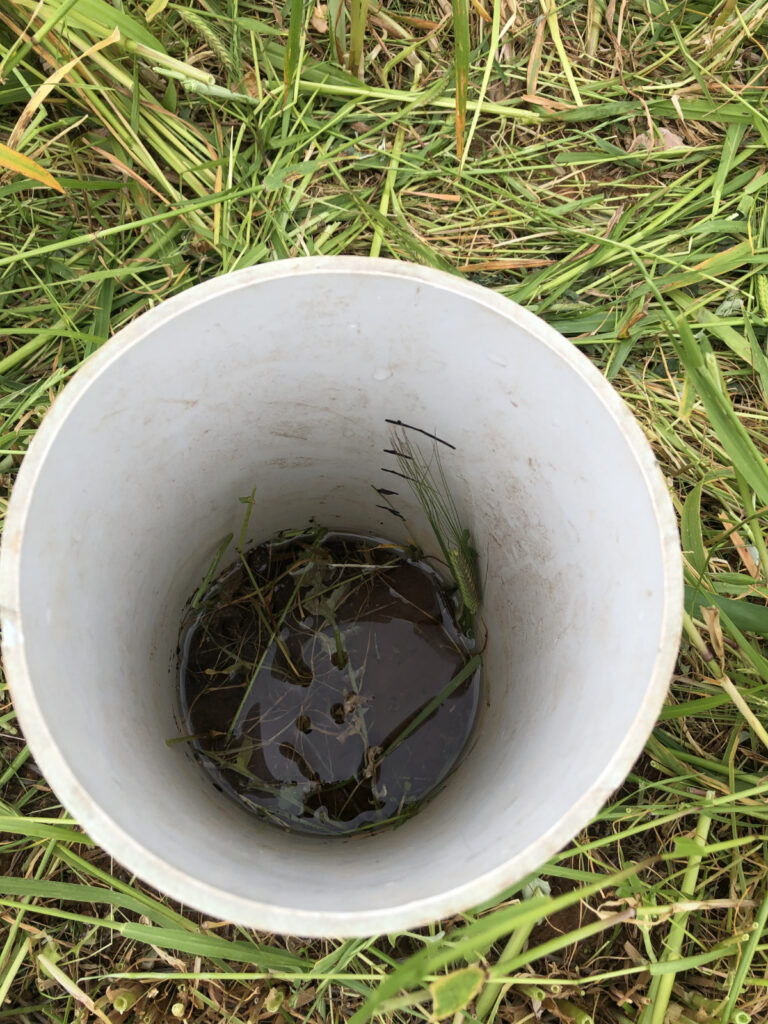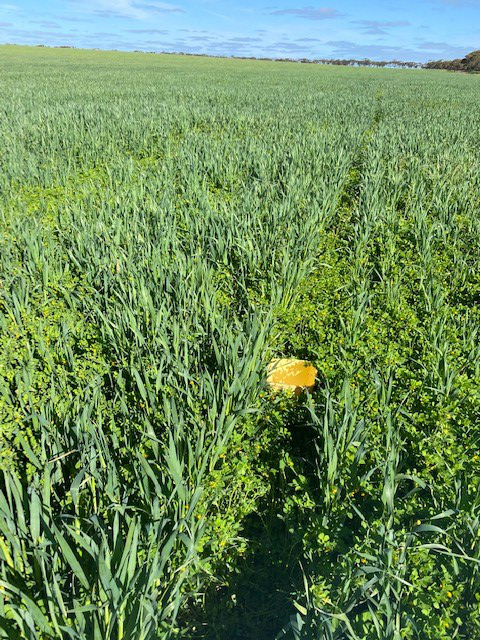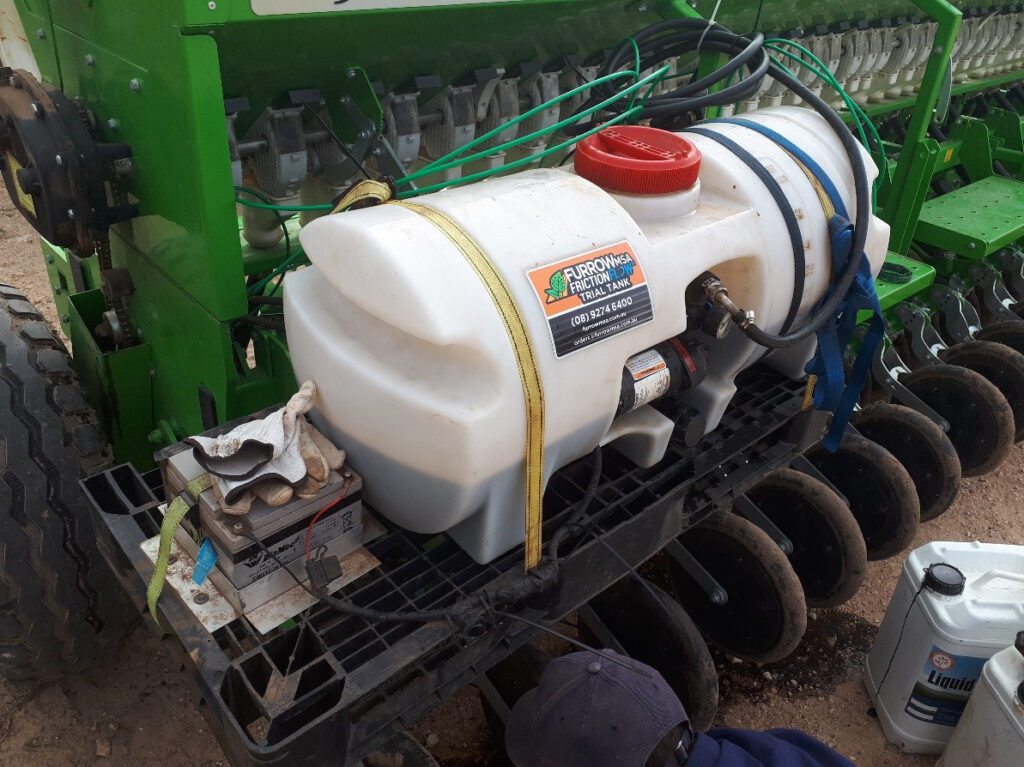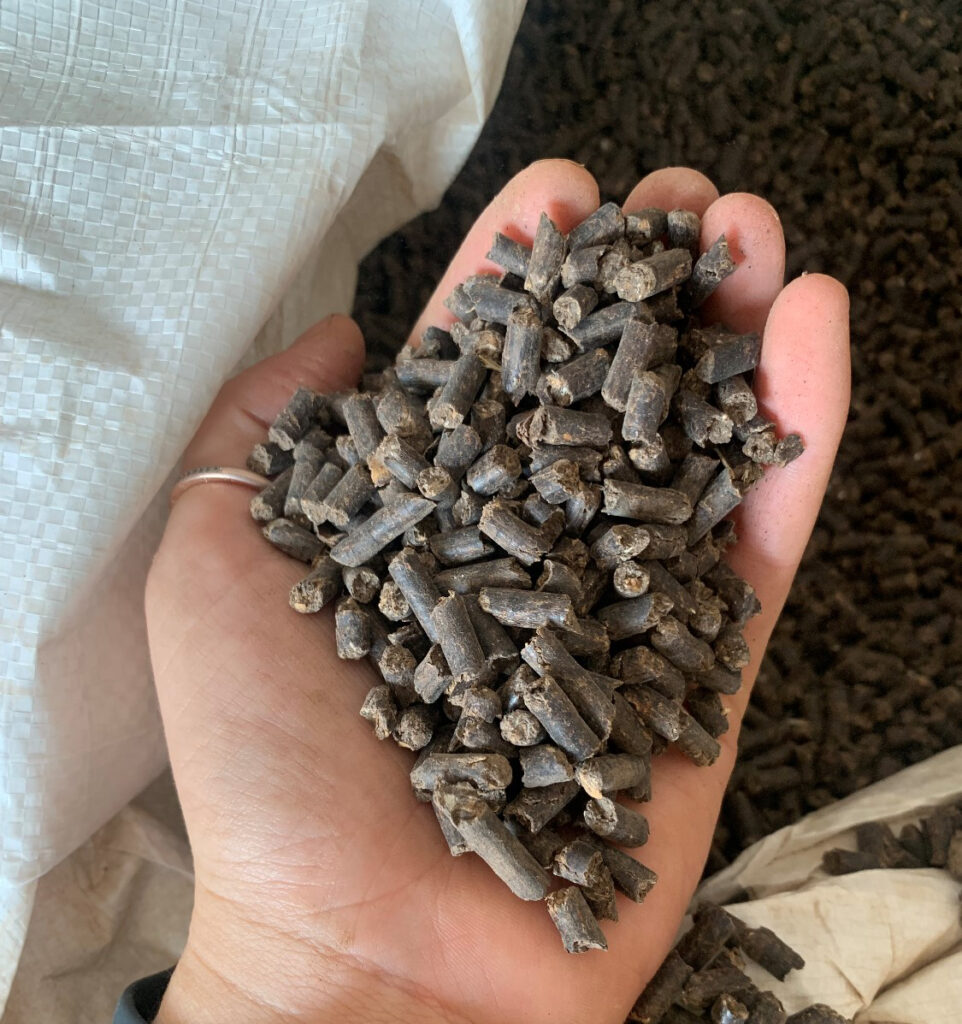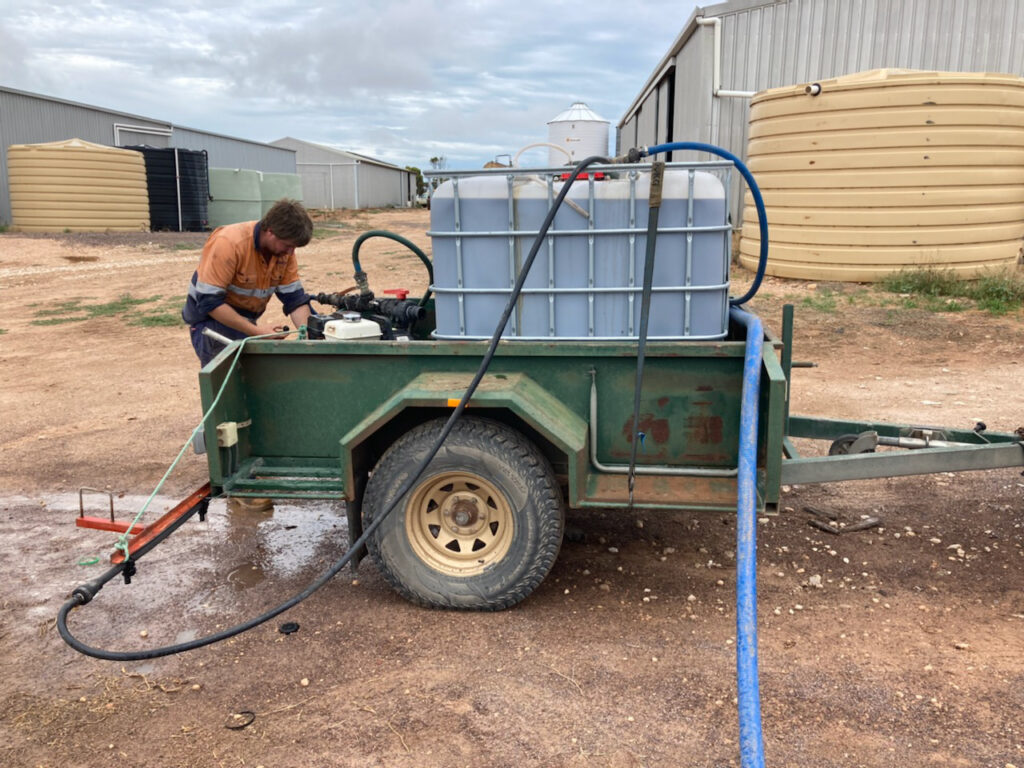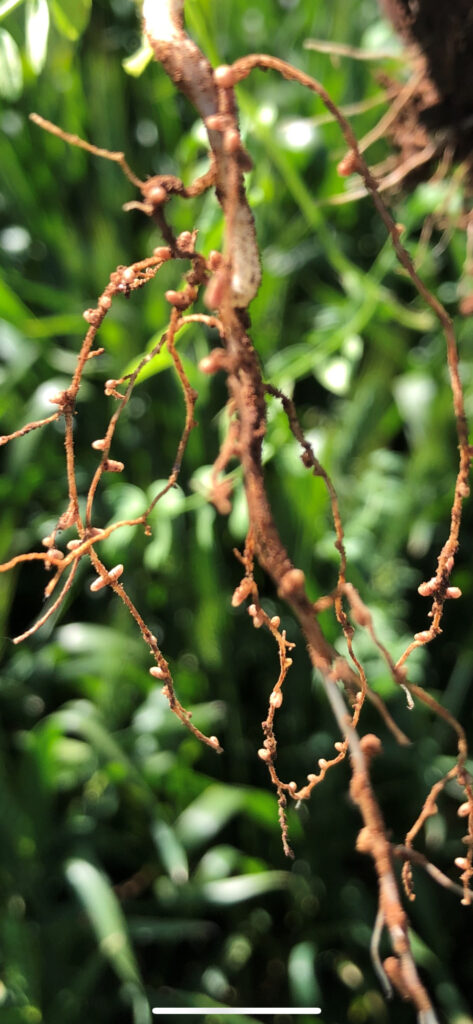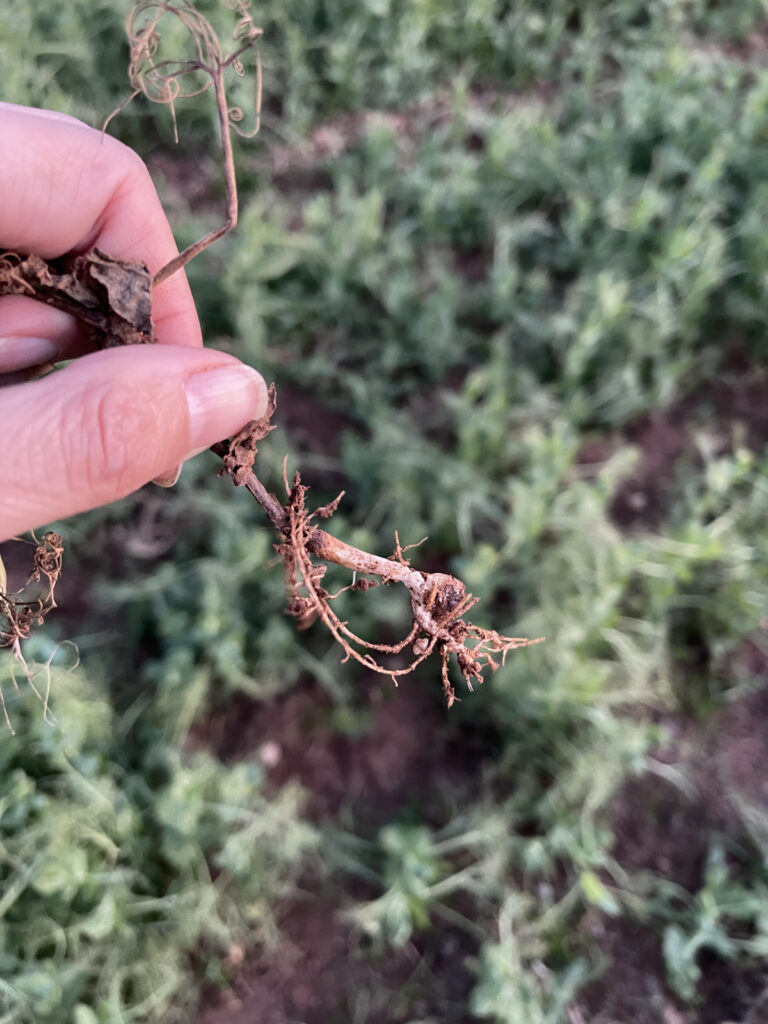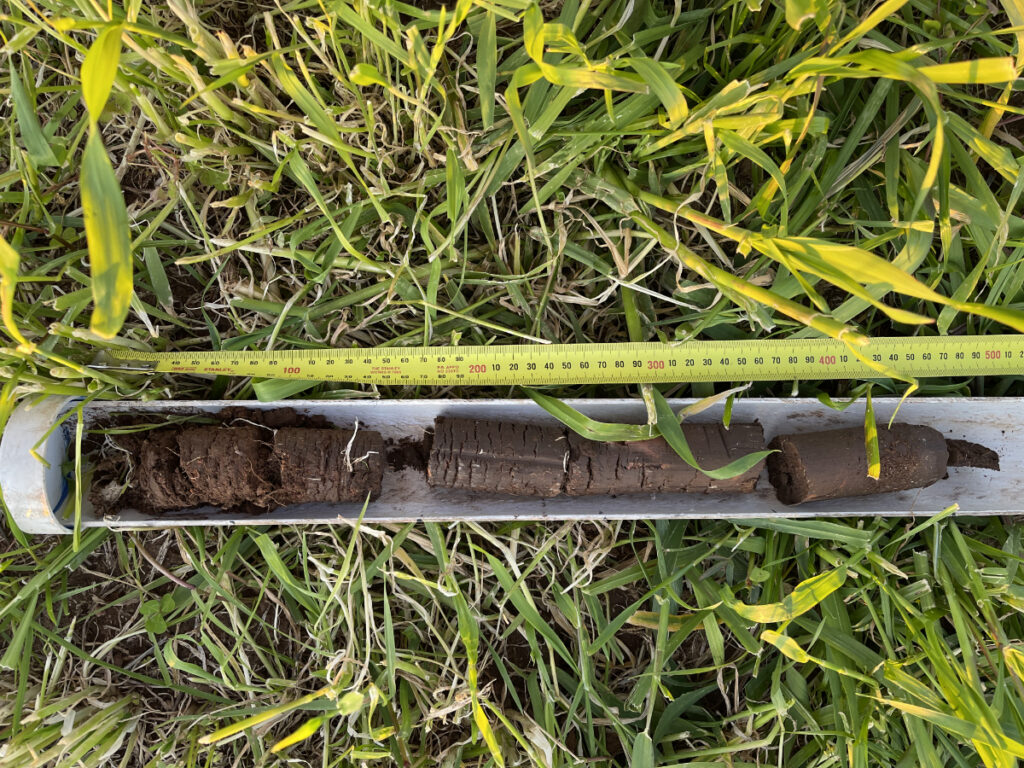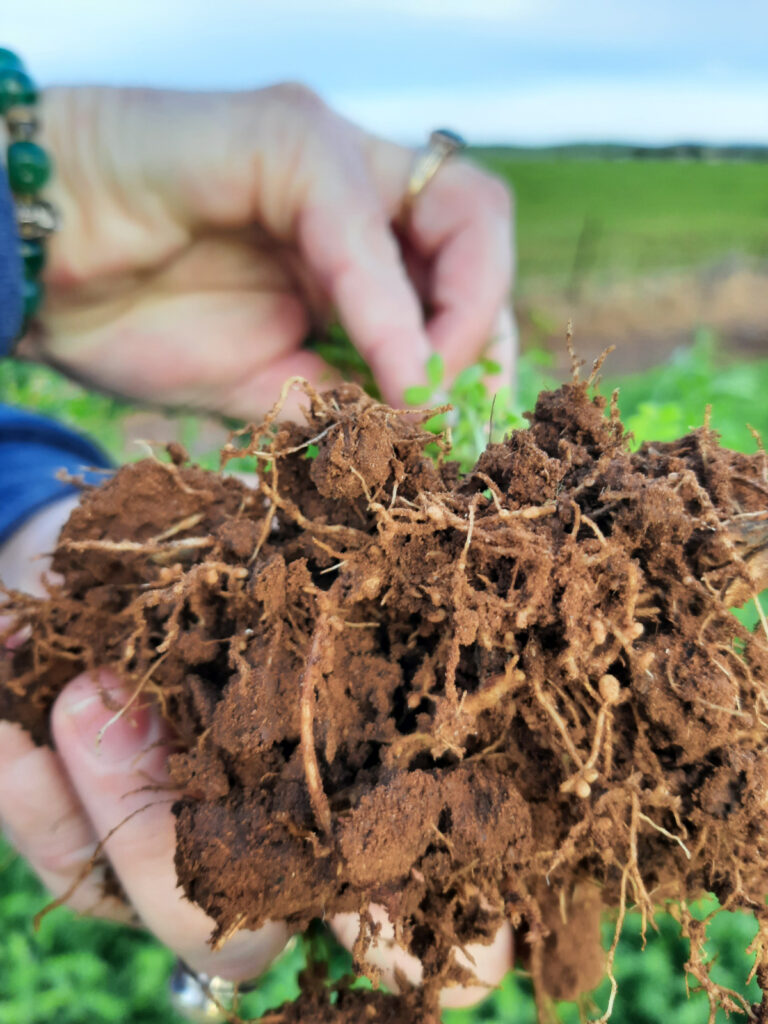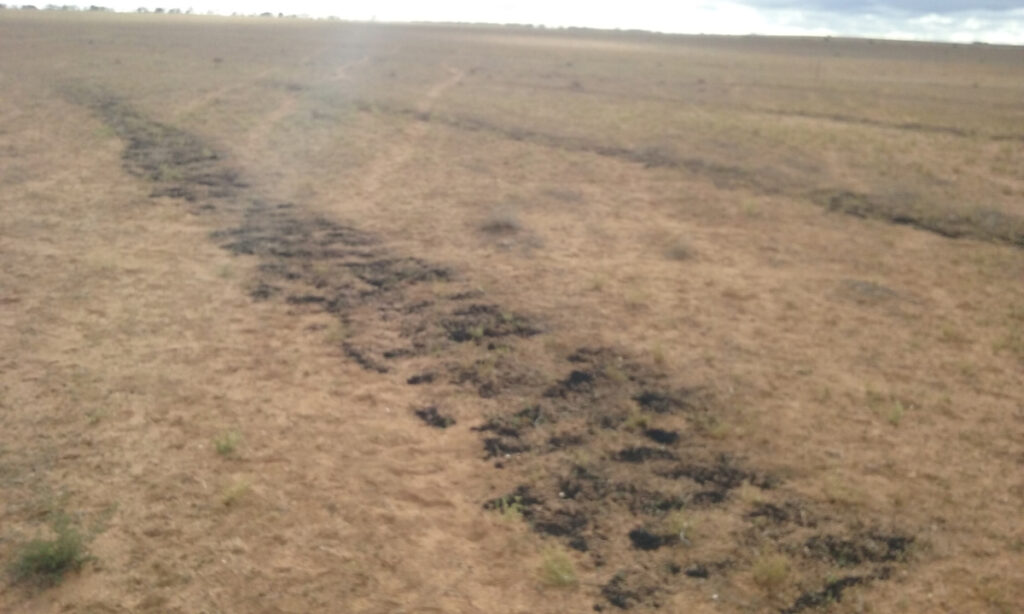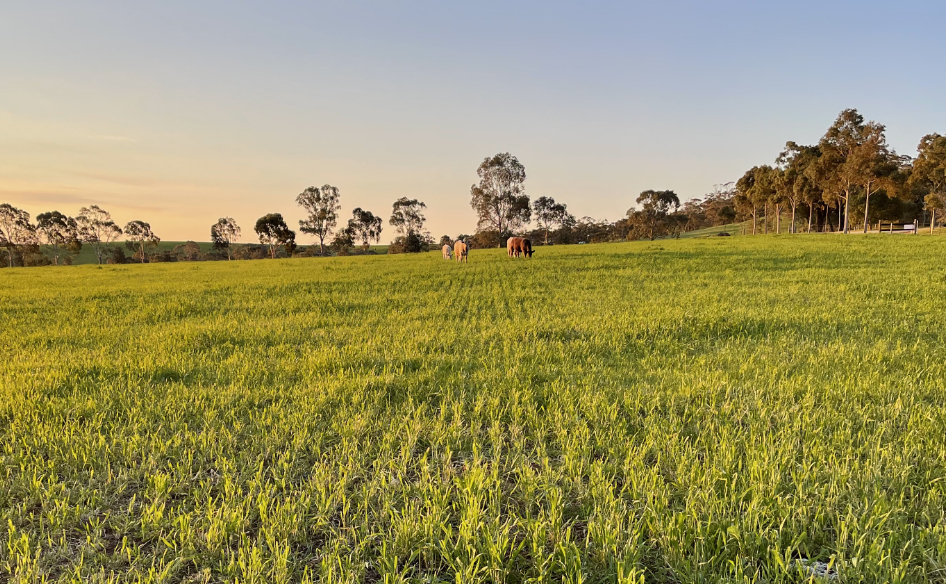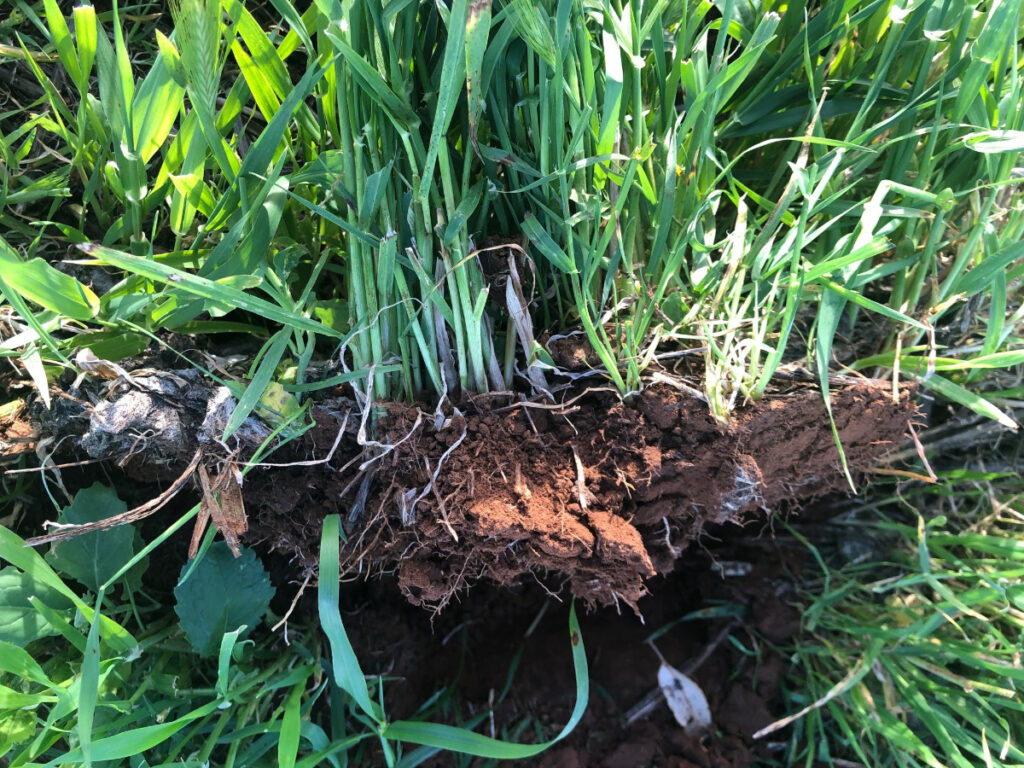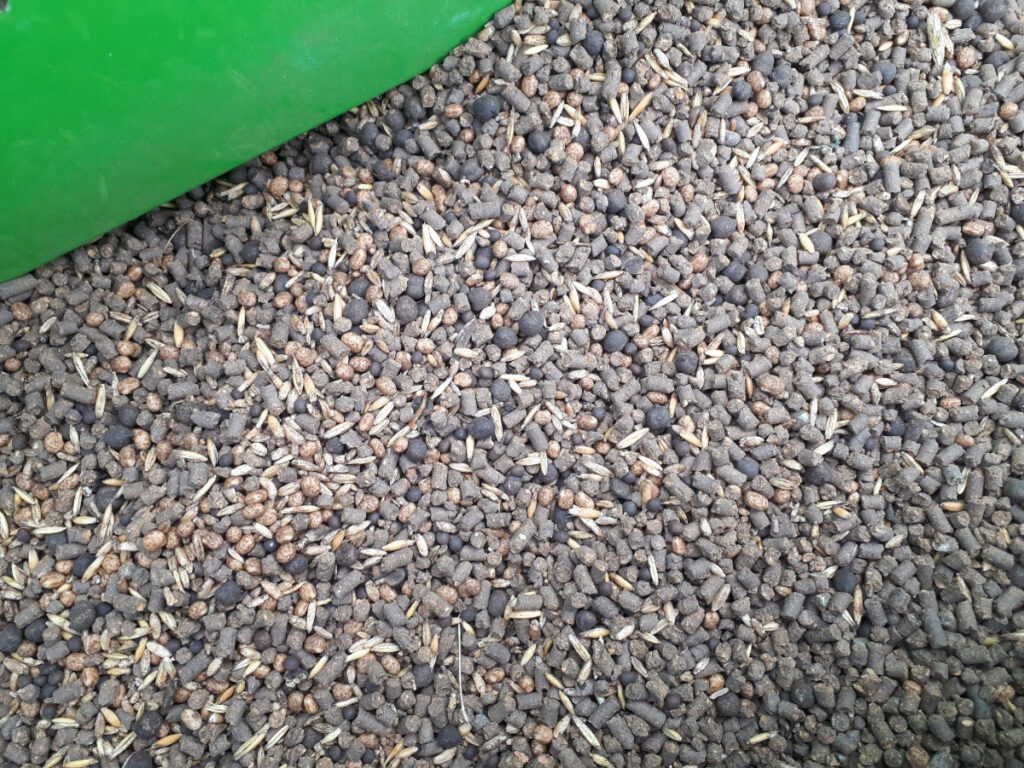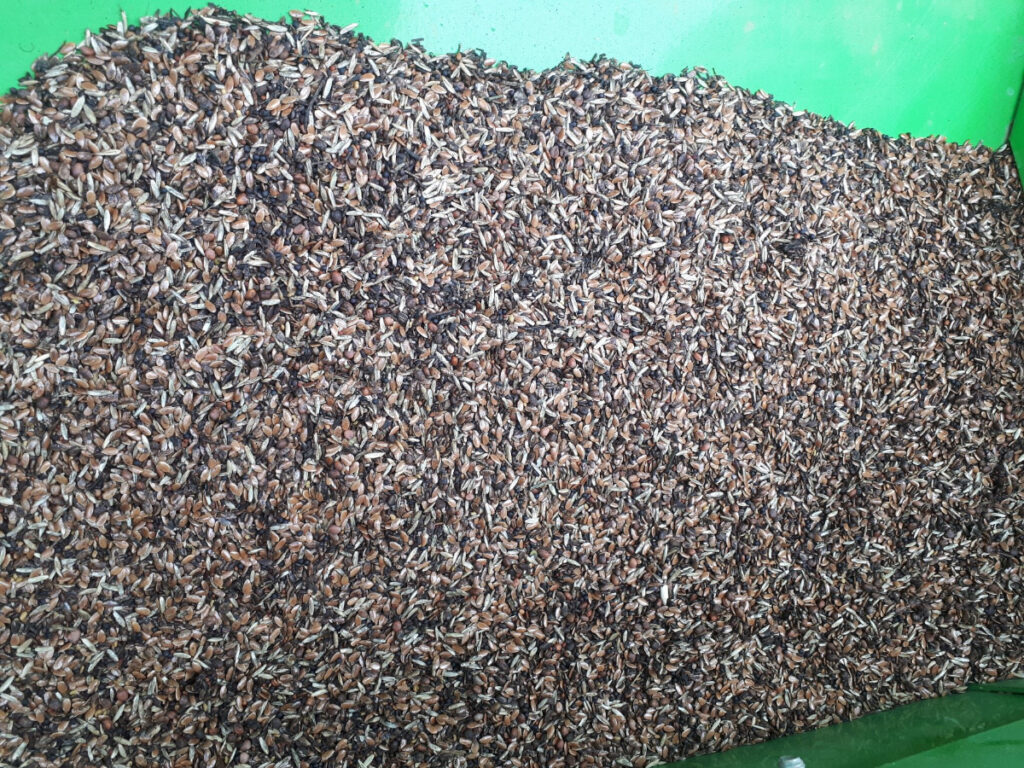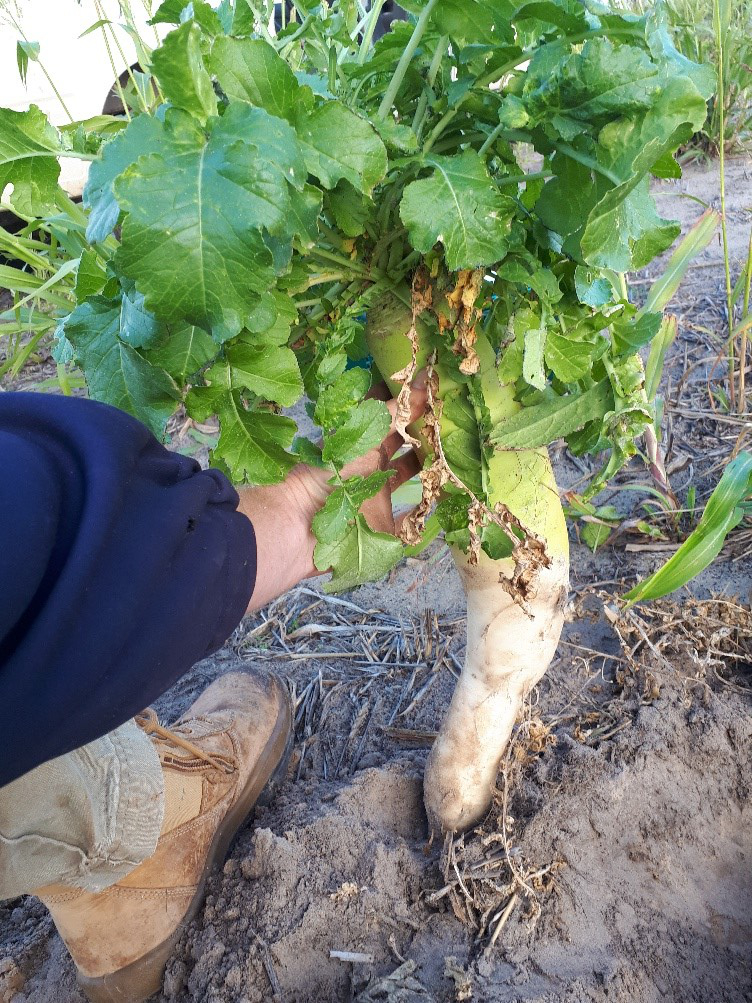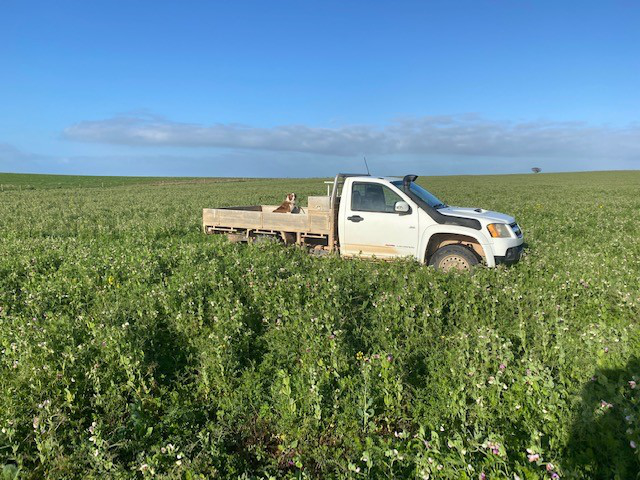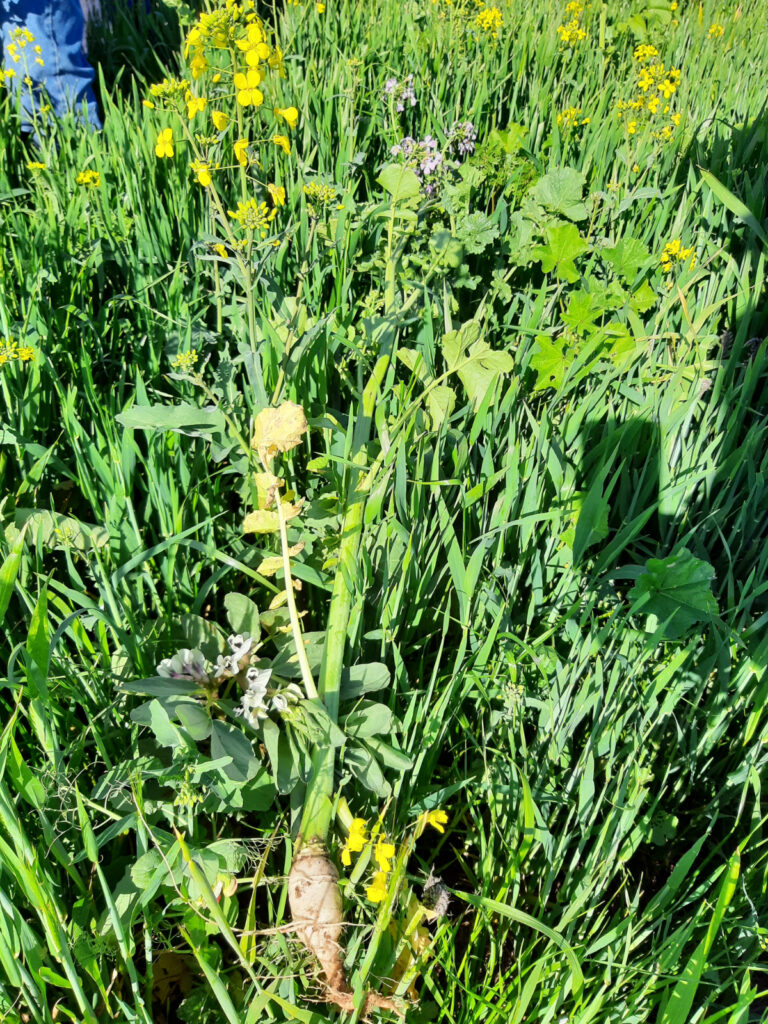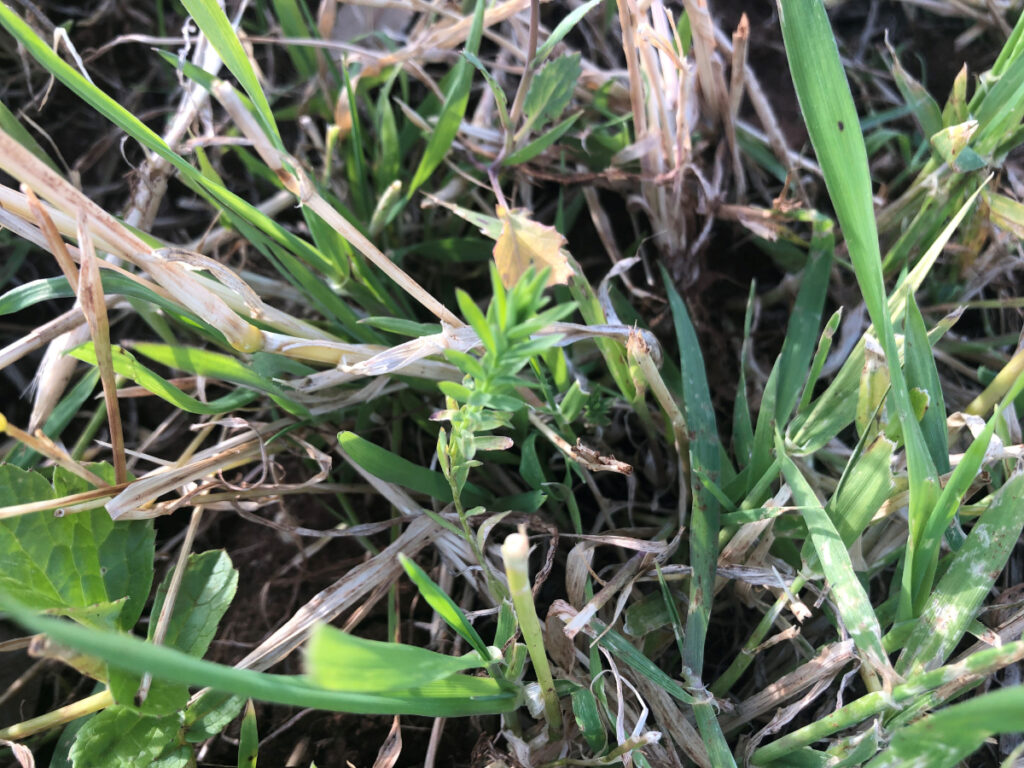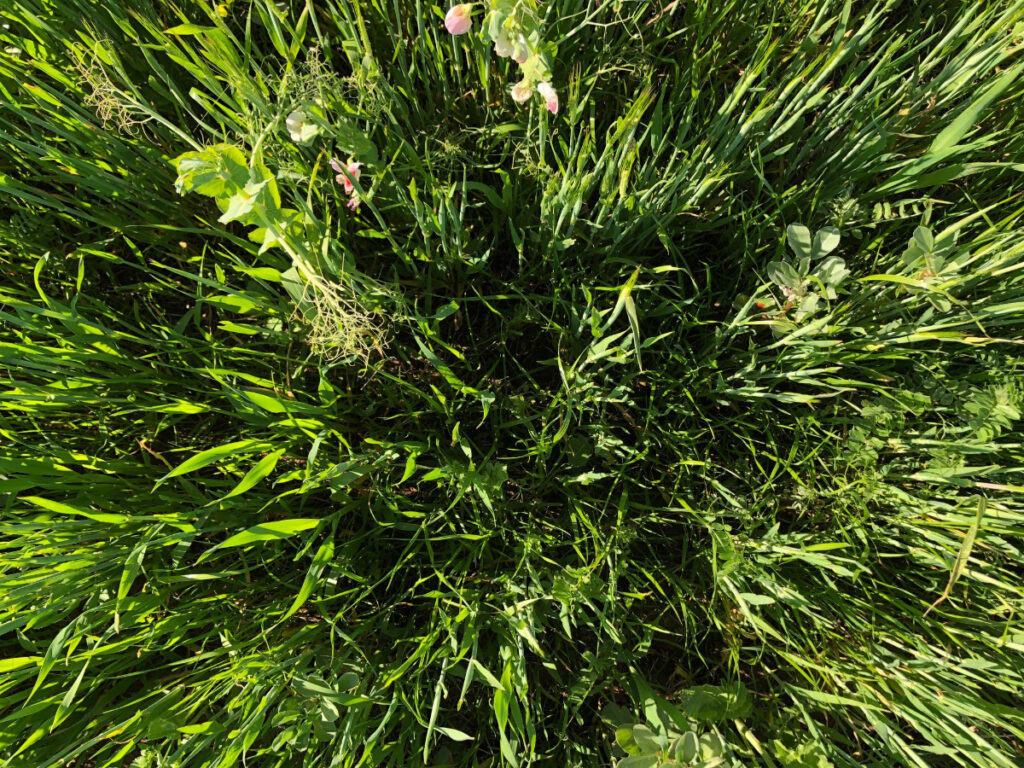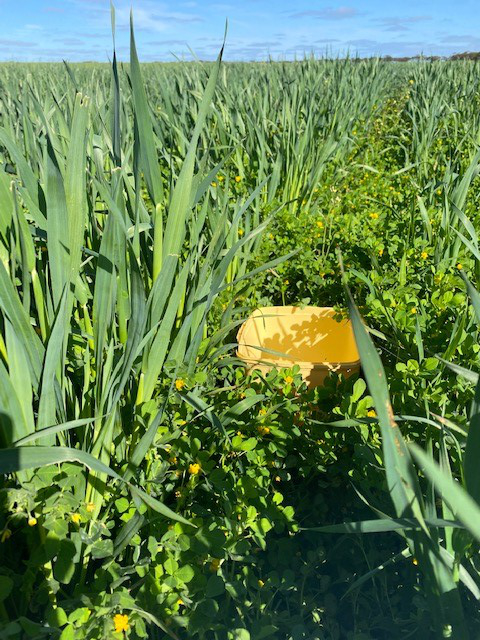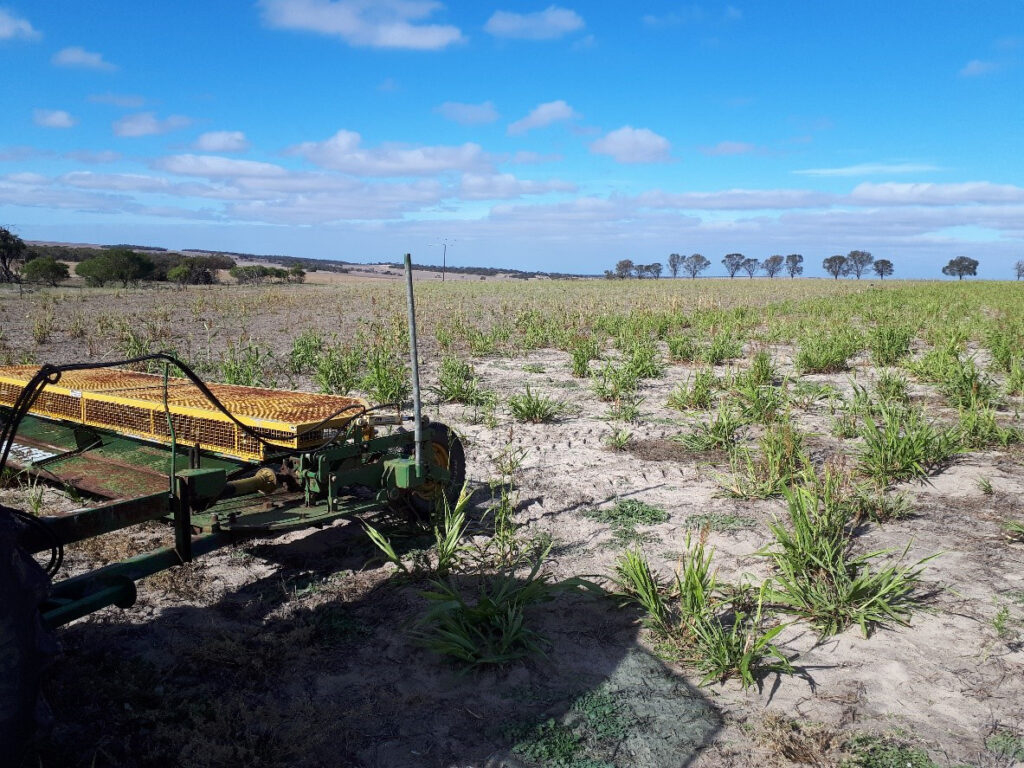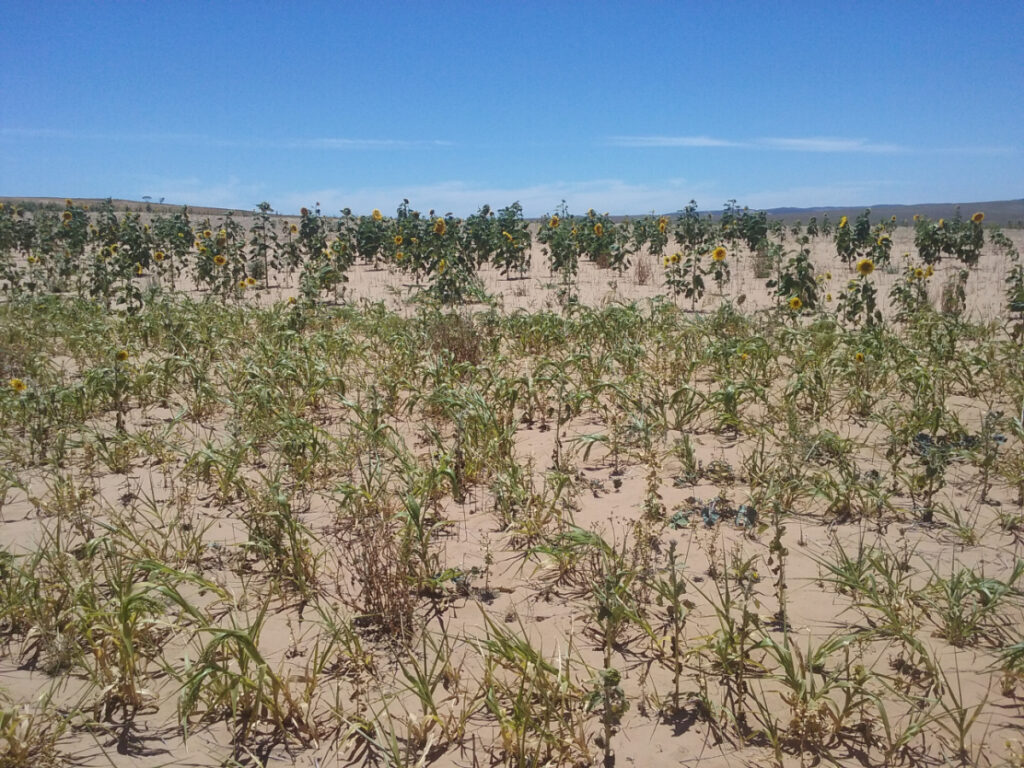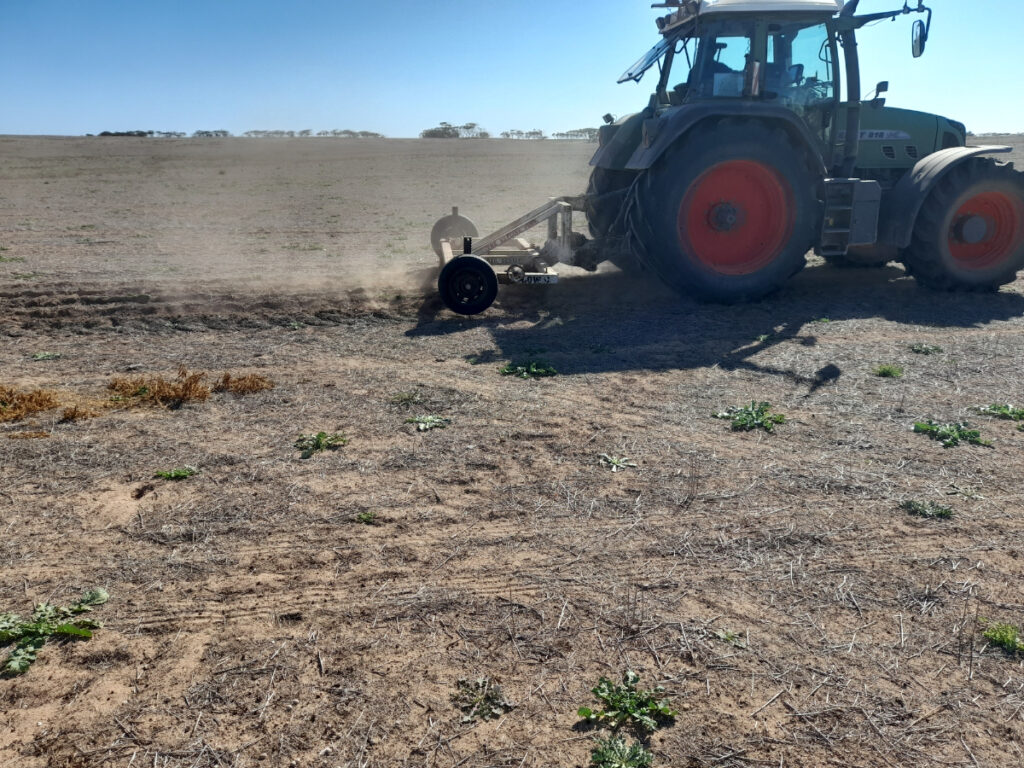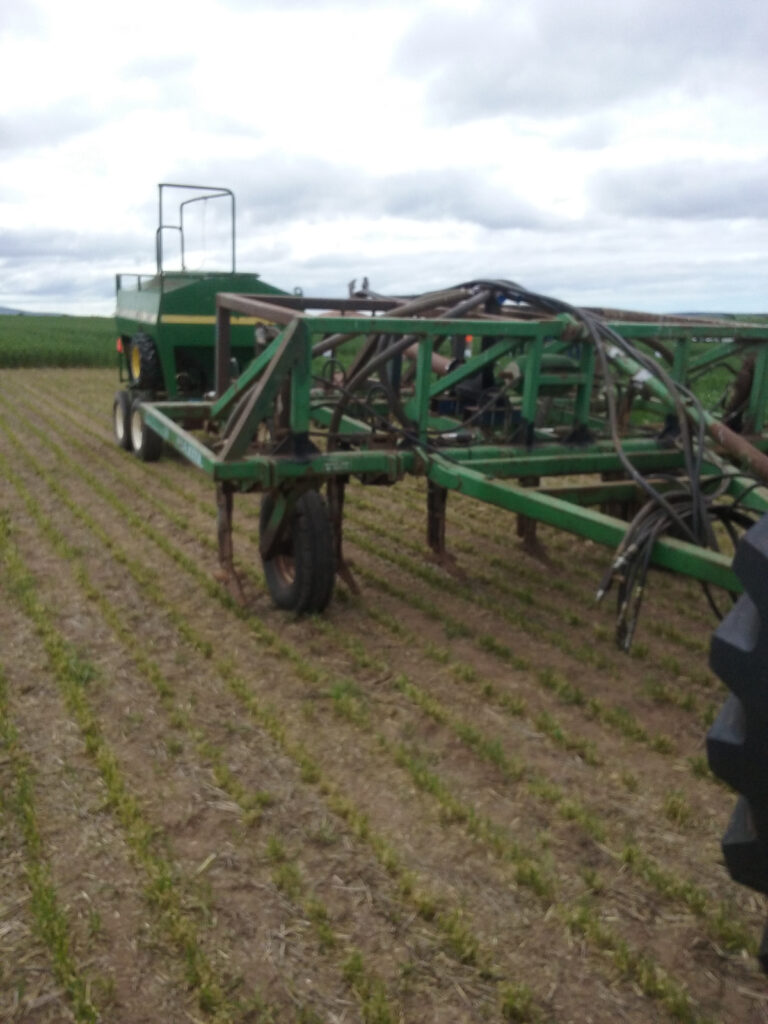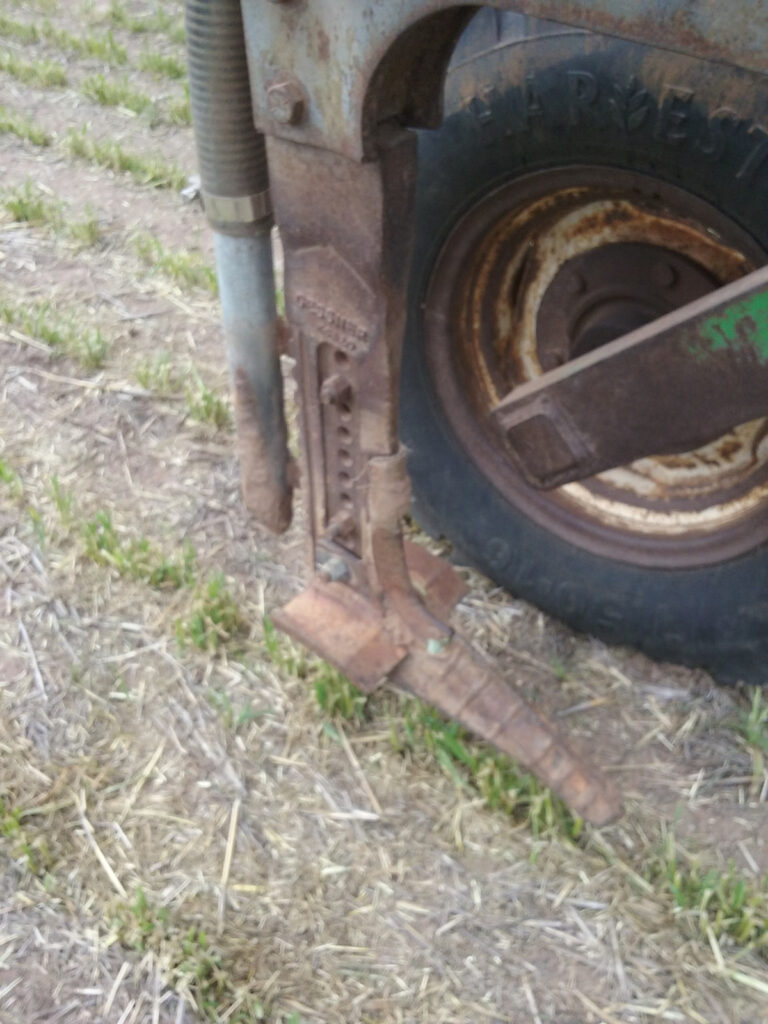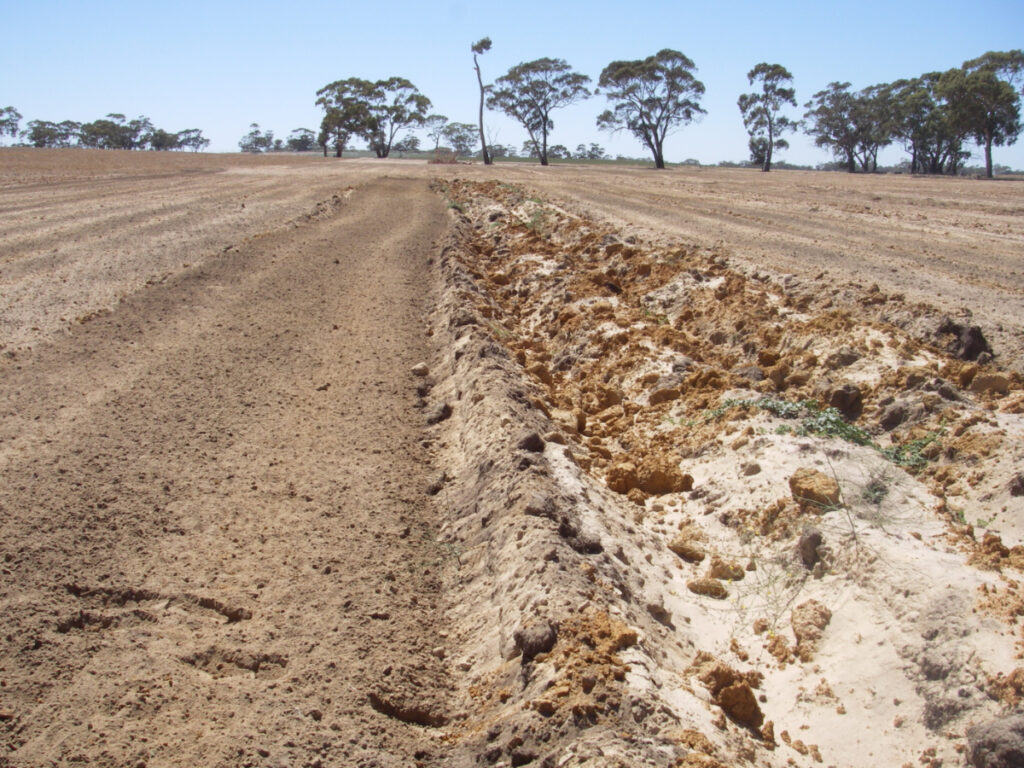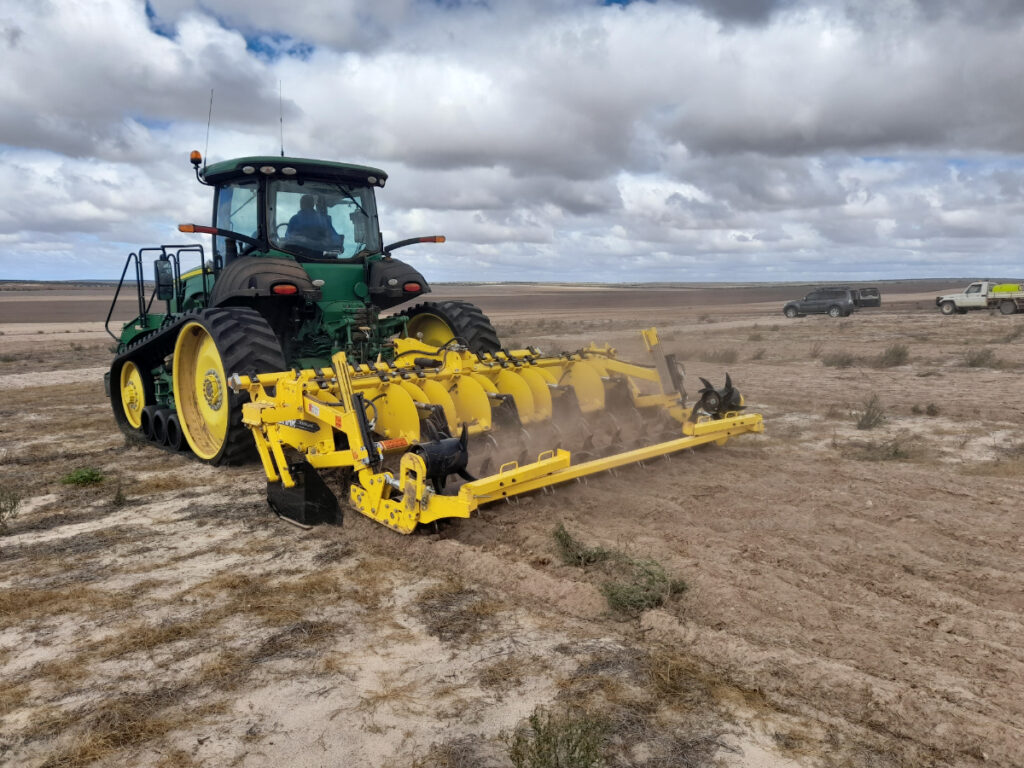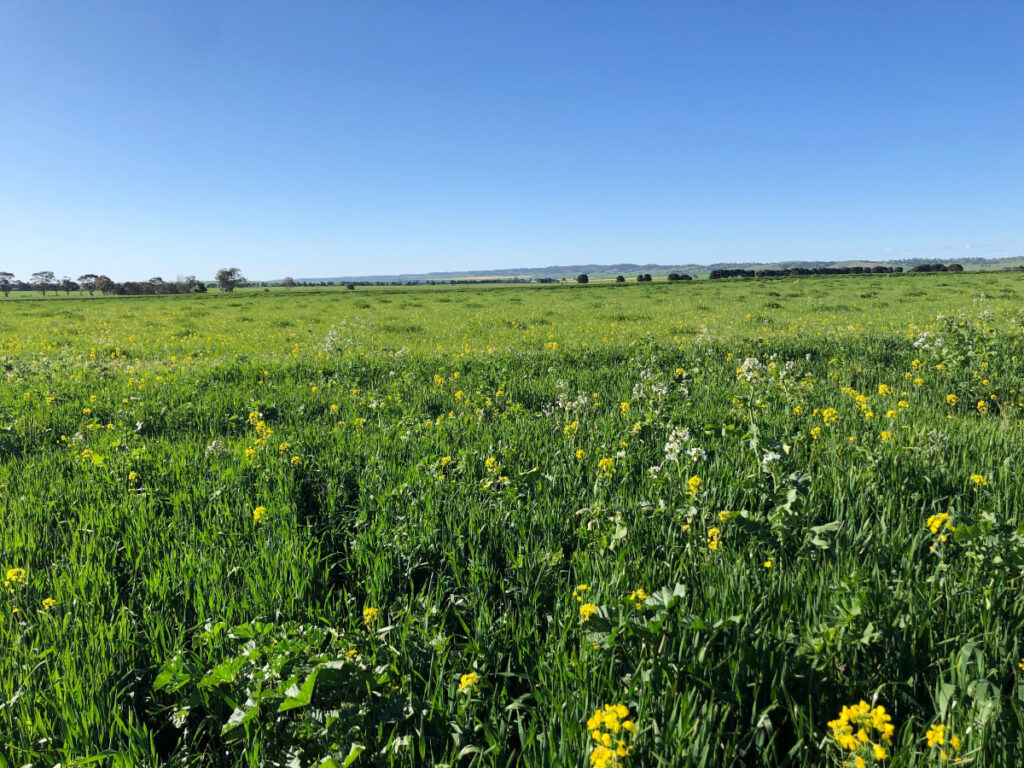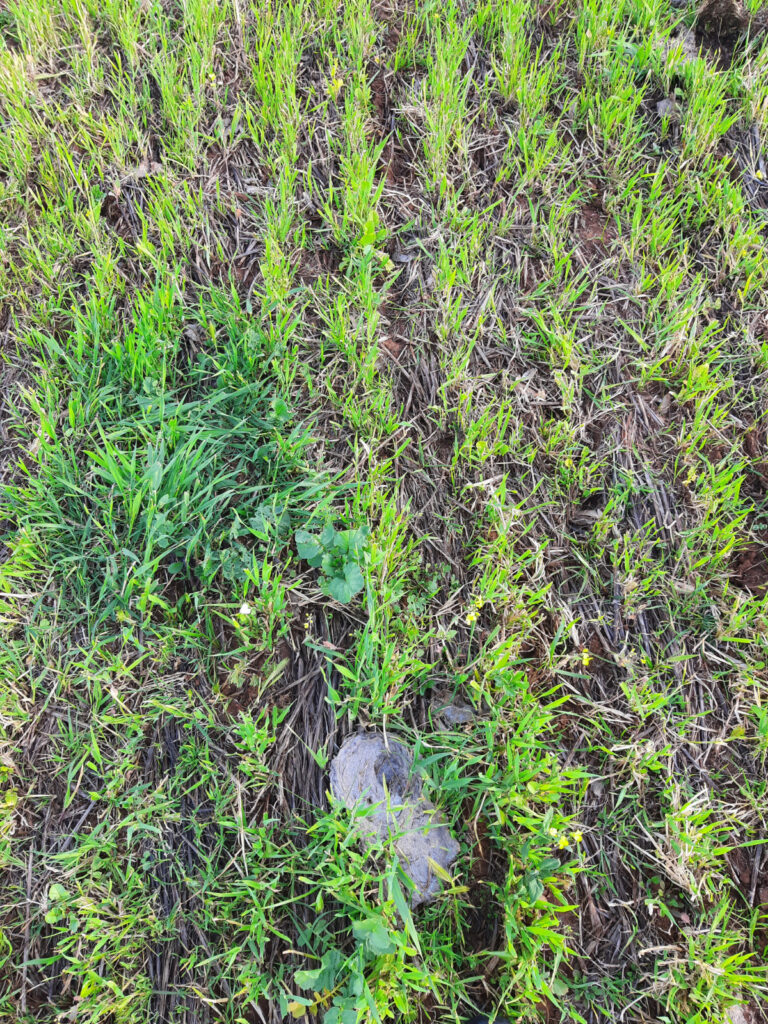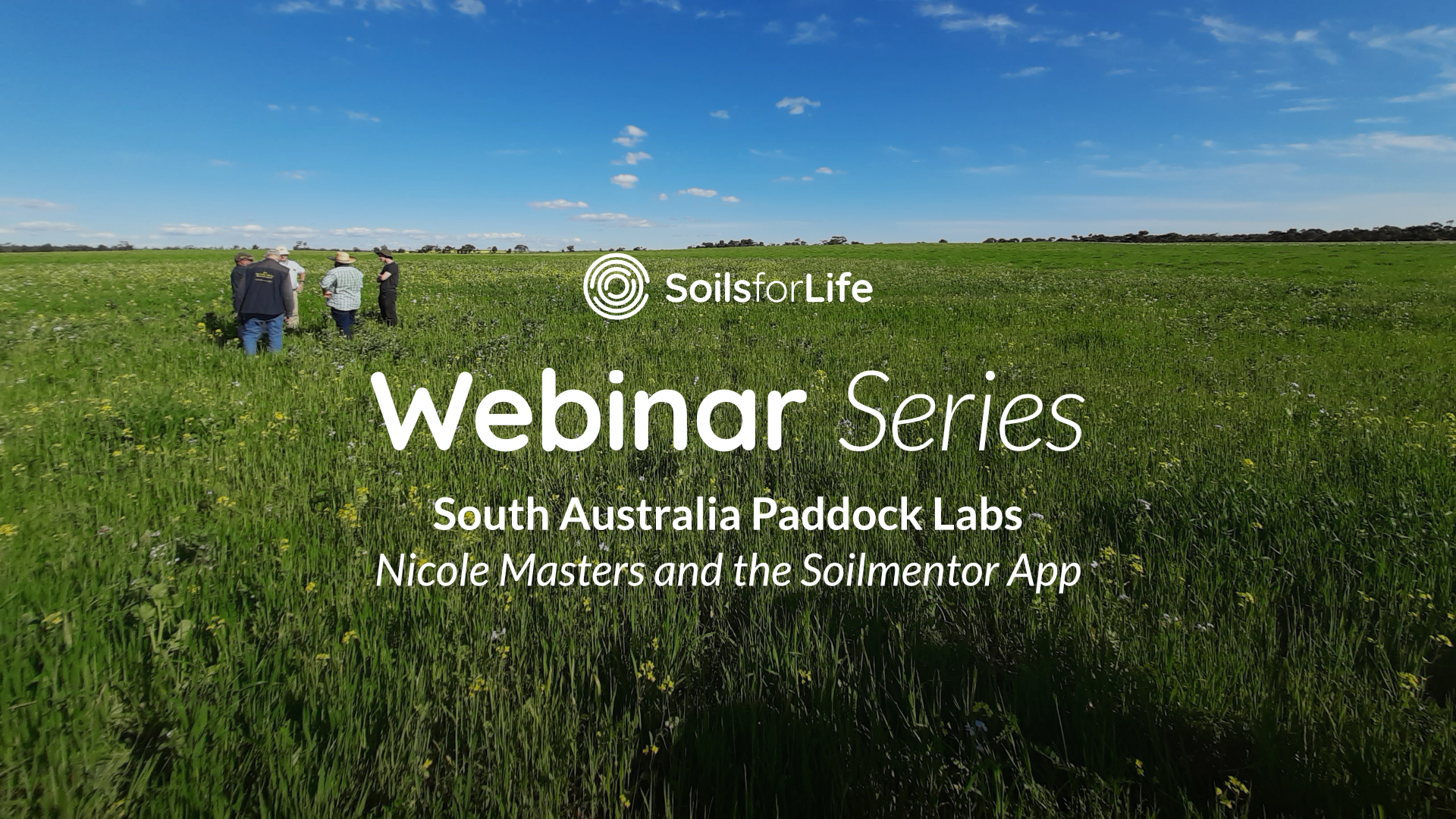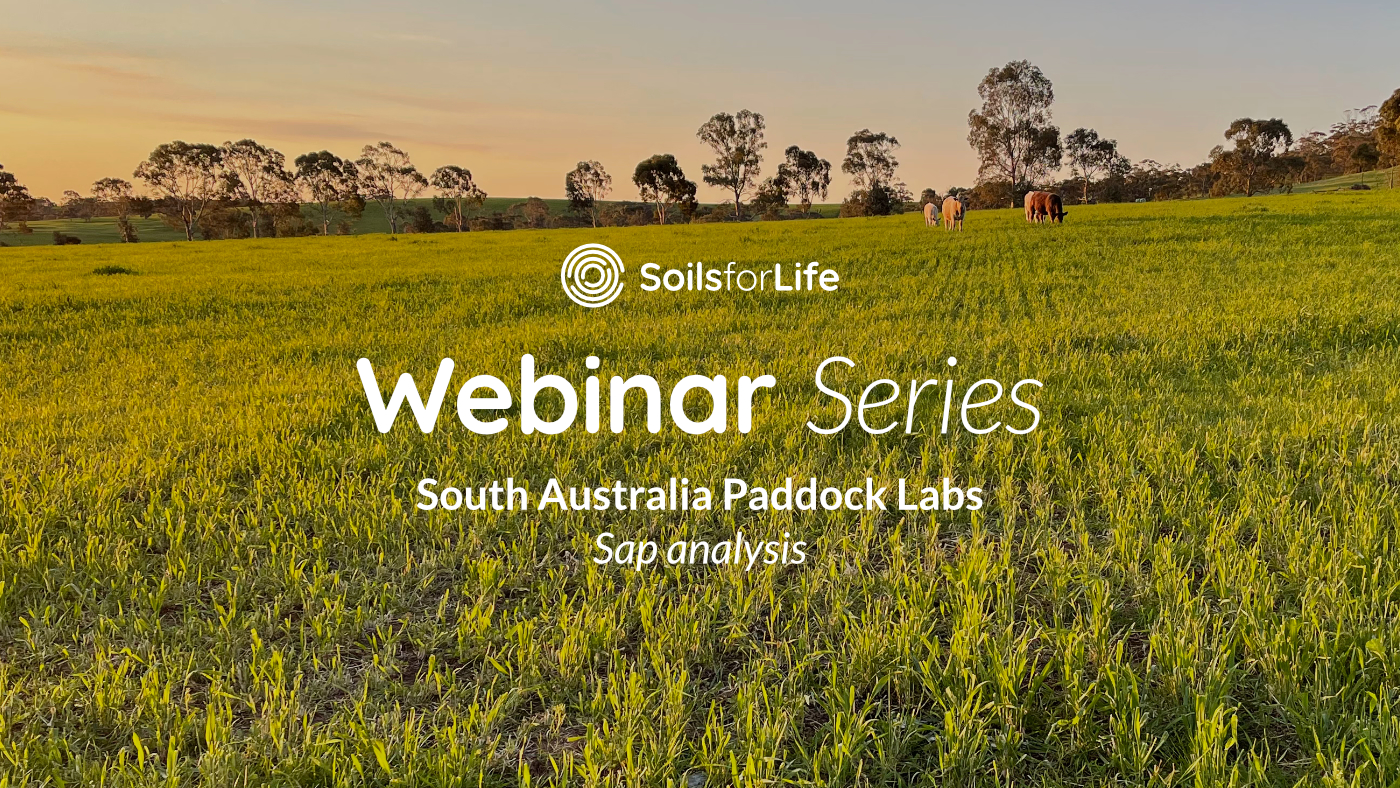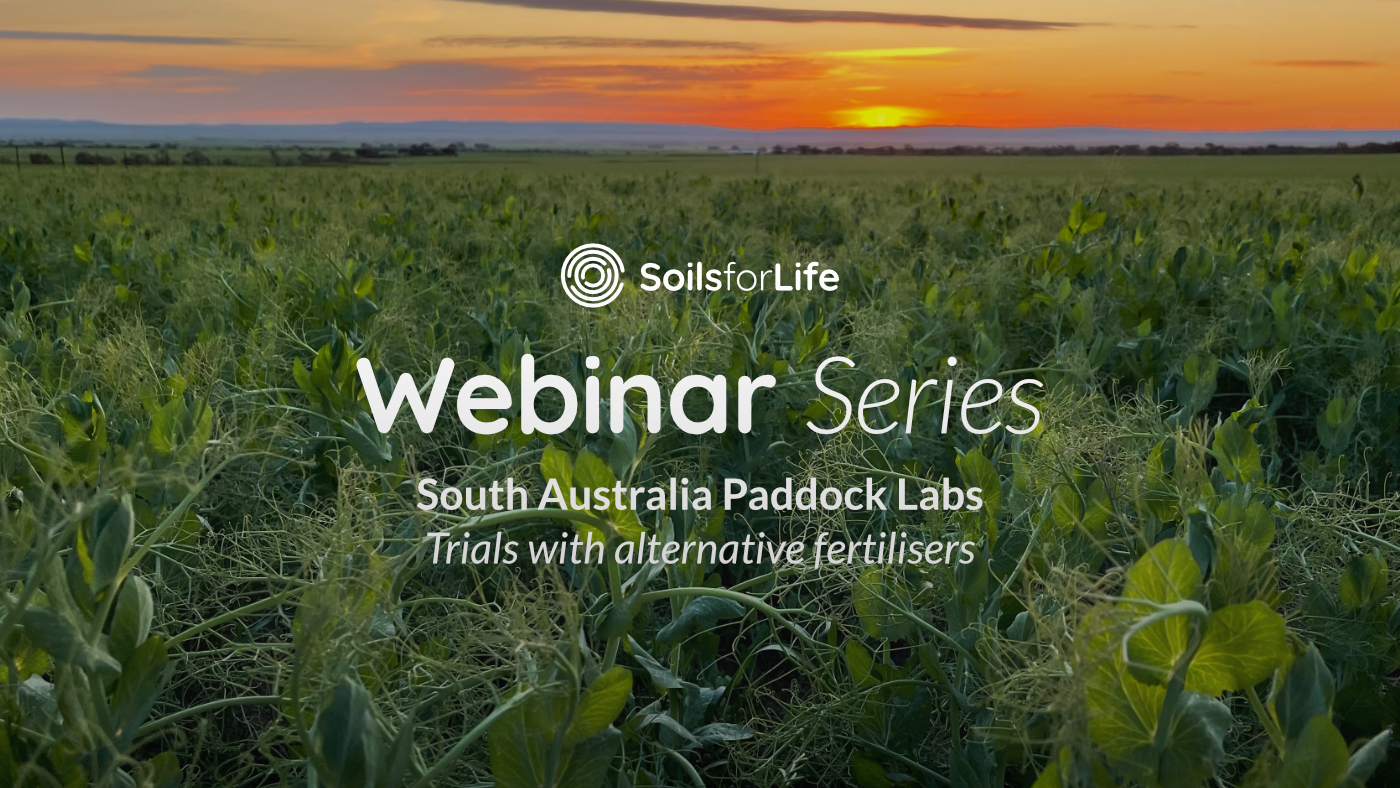'South Australia Paddock Labs'
Paddock Labs for Drought Resilience | February 2023
Over the last several decades Australian crop growers have been increasingly challenged by rising temperatures and input costs, increasing rainfall variability, and declining soil health.
Improving soil health is widely recognised as a key mechanism to address these challenges, not least for improving drought resilience. Healthy, functioning soils store water by acting as a sponge. This below-ground sponge:
- Increases the effective capture and storage of rainfall…
- which improves water use efficiency potential and decreases reliance on other sources of water, and…
- thus reduces the impact of drought and enables landscapes to recover faster.
Innovative Australian croppers have been leading the way to build healthy soils for drought resilience.
In this ‘Paddock Labs for Drought Resilience’ project (2021-2022), we supported experimentation with, and adoption of, drought resilient cropping practices in South Australia.
This project is supported by Soils for Life, through funding from the Australian Government’s Future Drought Fund.
Project goals
The Paddock Labs for Drought Resilience project sought to build landscape and farmer resilience to drought.
To build resilience, the project aimed to strengthen self-reliance, productivity and profitability, by:
- Reducing input costs and increasing profitability of farm businesses
- Improving soil health and other natural capital function (i.e. biodiversity)
- Building innovation and adaptive capacity of producers
- Strengthening knowledge-sharing networks for producers, to build confidence for ongoing practice change
- Developing a scalable approach to extend to other regions in Australia.
Participating crop growers
Two groups of crop growers in South Australia’s Eyre Peninsula and Northern and York NRM regions participated in the project.
Of the ten participating farmers from Eyre Peninsula, one continuously grows crops, while nine have a mixed cropping and grazing enterprise (with most averaging at 70/30 split of cropping to grazing).
Ten of the Northern and Yorke region participants also have a mixed enterprise (with all but two having a greater focus on cropping).
One participant in the Northern and York region has a biodynamic orchard.
Eyre Peninsula and Northern and Yorke regions
The Eyre Peninsula and Northern and Yorke NRM regions have low and highly variable rainfall (averaging between 300 mm and 600 mm per year).
The average annual rainfall for the ten Eyre Peninsula properties range from 350 mm to 480 mm (with an average of 400 mm across all sites).
Participants in the Northern and York regions receive a slightly higher annual rainfall, with an average across all 10 properties of 460 mm (and with a range from 330 mm to 670 mm).
The soils in the regions are variable, often with old, highly weathered subsoils and low nutrient and water-holding capacity. Soil constraints include sodicity, alkalinity, salinity, acidity, erosion and low biological activity. During the previous century, low levels of ground cover resulted in extensive wind erosion on lighter (sandier) soils and increased dryland salinity on some heavier soils.
The ten participants in the Eyre region have predominantly sand to sandy loam topsoils, with two sites having a sandy clay loam topsoil. Soils range from non-wetting sands, poorly structured, acidic,
ironstone soils to highly calcareous, loamy sand to sandy loam soils.
Most of the ten participants in the Northern and Yorke peninsulas have brown (or red) sandy clay loam Sodosols (texture-contrast, sodic soils). The most northern of the landholders has red, highly calcareous, sandy loam soils and the most southern of the landholders has highly calcareous, grey, yellow, and red loamy sand and sandy loams soils.
Cropping rotations in the medium rainfall area (400-600 mm per annum) involve a combination of cereals, legumes (faba beans or lentils) and canola. In lower rainfall areas, cereals are grown with varying lengths of pasture break, and, where the soils suit, a legume in the rotation.
Stubble retention and no-till practices were widely adopted in the last two decades and have led to considerable improvement in soil management. Yet due to the soil constraints, these regions deliver low crop and pasture water use efficiency; and increasingly drier and hotter conditions have resulted in declining yields over extensive areas.
Project process
Run in 2021 and 2022, the Paddock Labs project used an innovative farmer-led model, in which crop growers were invited to participate by a local soil scientist and Regional Agricultural Land Facilitator.
The crop growers who signed up had an interest in drought resilience and soil health, and were keen to meet other like-minded people.
The project also involved selecting a ‘focus farmer’ in each region whose innovations were more established than the other participants. (For example, focus farmer David Foster is ten years into his soil health journey and is at the point where he was able to avoid fungicides even during this wet season).
Run in 2021 and 2022, the Paddock Labs project used an innovative farmer-led model.
To support a step-change in cropping and mixed-farm practices through farmer-led innovation, the project:
- Supported crop growers to choose the drought-resilient practices they were most interested in and wanted to trial on their farm
- Offered technical support from an experienced local soil scientist to adapt, test and validate the options
- Provided tools for crop growers to monitor the influence of these trials on soil health (e.g. in-field observations using a specialised phone application to store data), and
- Created a peer-to-peer learning group for participating crop growers to share their questions, experiences and insights.
Often a wide community of peers with similar interests is hard to find in each district, so the Paddock Lab project supported crop growers with peer learning around these practices. Participants who might have been uncertain were keen to learn from those who were already implementing the new practices.
The capacity building and peer-to-peer learning sessions were both in person, and online, and included such topics as:
- Developing on-farm compost
- How to use the vidacycle’s Soilmentor app
- Plant sap tests for determining foliar applications
- Monitoring root health.
Resilience: being able to ‘iron out the highs and lows’ of farming
Participating farmer
What does resilience mean to these farmers?
The crop growers described resilience in the landscape as the ability of the land to adapt to and withstand changes, and believed that ‘having cover on the soil and having good soil structure is your best defence.’
Farmers identified that a resilient landscape could support a productive pasture across a range of climatic conditions, including droughts. To do this, most farmers noted the importance of building up organic carbon to store nutrients, microbiome and water for plants during times of drought.
To be a ‘drought-resilient business’, farmers described the importance of ‘a really well managed business that is economically viable’. To them, being economically viable means reducing the impact of external factors on their farm’s productivity, for example becoming less reliant on high inputs and high outputs.
One farmer summarised this approach as ‘not shooting for the big, high-yielding crops with lots of inputs where things can go wrong’ and instead focussing on ‘district average yields with less monetary inputs’ where the ‘payout is in the gross margin’.
“If you have a business model that allows you to pull different levers to tune it to different climatic conditions, you have a drought-resilient business”
Participating farmer
Farmers described personal resilience as having knowledge and capabilities which could make them less reliant on others or on external situations. They spoke about the importance of farmers learning about soil health to be able to think critically about advice received.
Drought resilient practices
Alternatives to high-analysis fertlisers
What is this practice and who tried it?
Since the 1970s, the cropping industry has applied high-analysis (>30% total available nutrients), factory-based fertilisers. However, with rising costs and increasing price volatility, broadacre crop producers are considering alternative nutrient sources.
Most (14 of 20) of the Paddock Lab farmers, experimented with alternative fertilisers, which included a mix of commercially available products and innovative homemade solutions (see Table 1). The alternatives explored by farmers included manure, foliars, seed coatings, biological fertiliser mixes, and liquid urea and minerals.
Five farms used manure in some form, including composted manure as an ingredient within a liquid bio-fertiliser, by direct application, in pelletised form, and with phosphoric acid to adjust the pH of the product.
Four farms used foliar sprays to apply a specific mix of minerals and nutrients directly to the plants as needed. Two farms treated seeds directly with trace elements, growth promotants or fish products, and coated seeds with a carbon silica product.
Three farms have experimented with making their own bio-fertiliser mix, which can comprise a mix of ingredients including cow manure, trace elements, volcanic rock dust, and other natural sources. One farm purchased a pre-mixed biological fertiliser mix.
One farm experimented with biochar strips.
Table 1. Summary of alternative fertilisers used by 14 of the project participants, including innovative homemade solutions and commercially available products.
| Alternative fertiliser source(# of trialling farms) | Examples from participants |
|---|---|
| Homemade bio-fertiliser |
|
| Commercially sourced bio-fertilisers |
|
Whereas soil amendments are added before the crop cycle, crop growers who trialled the foliars were interested in providing specific minerals to crops at specific stages of growth to improve the resilience and yield of the crop. To determine which nutrients and trace minerals should be applied to improve plant health, producers can conduct a nutrient analysis of the leaf sap.
Sap testing is an emerging practice, where farmers are measuring the sap in plants for indicators of current nutrition, such as total sugars, potassium, calcium, magnesium, sodium, ammonium, nitrogen, etc.
Two farms implemented a sap analysis program, with four demonstration sites on Eyre Peninsula also having some exploratory analyses conducted. Most of the participants used visual tests to determine the health of the crops and soil.
As part of the Paddock Labs project, Soils for Life hosted a webinar on sap testing with Mark Tupman, a horticulturalist from Productive Ecology. Because sap testing is quite technical, expert advice is often recommended.
Webinar series: Sap analysis
Why did they try it?
There were several reasons why participants chose to trial alternative fertilisers.
For financial resilience, crop growers wanted to reduce, or remove entirely, off-farm inputs to improve their gross margin. Farmers with livestock and cropping wanted to reduce costs by recycling their own nutrients and materials on-farm in a manure compost.
In terms of personal resilience, another motivation was to reduce the use of chemicals to reduce impacts on human health. Some farmers reported that they were aiming to be more self-sufficient, and less reliant on external inputs or impacted by external factors. Farmers also believed that a low-input system would be more resilient to disasters such as drought or flood.
Participants also wanted to increase soil microbial health, soil productivity and plant health. They were motivated by their growing understanding of the impacts of synthetic fertilisers on soil health in terms of reducing soil organic matter, as well as the availability of minerals and nutrients in the soil. One farmer noted that synthetic inputs and high rates of synthetic fertiliser had made many nutrients unavailable in their soil, and hoped to address this by using alternative fertilisers.
What did they learn?
Towards the end of the Paddock Labs process, we hosted a peer learning session, where two focus farmers shared their experiences and lessons with alternative fertilisers.
Tom Robinson shares and answers other farmers’ questions about his experiments with summer crops and grazing, seed coatings, sap testing and foliars, and crop nutrition management. He also shares a video of his set up for coating his seeds with Johnson Su fertiliser and then transferring to the truck.
David Foster shares the design and results of his replicated trials with deeping ripping, companion planting with alternative fertilisers, such as manures, and what he calls synergy planting. He talks about the benefits of sowing wheat and beans and sweat corn and beans together, including a ‘doubling of root mass’ and nitrogen deficiencies where the beans weren’t included.
Webinar series: Trials with alternative fertilisers
In addition to the insights from each of their specific trials, farmers shared how they increased their general knowledge about soil and plant health. Through trialling and discussing alternative fertilisers, participants had an increased understanding of soil health, microbiology, soil nutrient availability, and in particular, the importance of soil structure, texture and moisture for supporting microbial life, and for microbial life to support crops.
Many farmers also noted the importance of a shift in focus from gross yield to gross margins. They now feel a more cautious approach to spending on inputs was a key factor in maintaining their enterprise through the good and bad years.
After trialling sap analysis, one crop grower suggested that crop growers who want to do sap analysis should start by considering four key questions:
- How to ‘collect’ the samples? (the participant sampled the oldest and the newest leaf growth)
- Which laboratory to send the samples for testing? (the participant uses a laboratory in the Netherlands).
- How to get the samples to the laboratory?
- Who will help interpret the results to decide which foliar to apply?
What were the benefits?
The perceived benefits of this practice included the reduced reliance on inputs (and therefore lower input costs), as well as an increase in plant health and yield. In addition, some farmers noted benefits relating to landscape management and personal well-being.
Minimising risk through cost reduction
A primary benefit reported by the farmers was the reduced cost of inputs. Based on their experience, participants described alternative fertilisers as less expensive overall because of how efficient the products were and the lower application rates required (compared to synthetic fertilisers). One farmer also noted that the ongoing cost of creating their own bio-fertiliser was significantly cheaper than purchasing a fertiliser, and that the cost of the machinery needed to implement the practice had paid for itself within the first year.
In addition to spending less on fertilisers, participants also noted the co-benefit of a reduced need to apply herbicides, fungicides, and pesticides, lowering the cost of inputs even further. One farmer noted that these reduced costs allowed them to “turn a profit” even during the dry and El Niño years, resulting in a more resilient business.
Foliars in particular were reported as playing a significant role in reducing other inputs, as they allowed the specific application of a combination of required minerals and nutrients and could be delivered in a bio-available format at the right time for the plant. This level of accuracy and precison ensured that the minerals and nutrients were applied in the right quantity and at the appropriate time, resulting in less waste and lower costs.
Improving productivity by strengthening soil health
Farmers noted that the soil health and productivity of the land was improving. Although many of the farms experimented with a range of techniques, it is likely that the alternative fertilisers have contributed to the improved yields in combination with the other techniques applied.
Farmers that have used this practice over several years noted that they have more stable yields across good and bad years. Having a stronger microbial life was also associated with less need for fungicide, with one farmer noting that their yields were noticeably stronger than surrounding farms who had sprayed this past season.
Those producers who just started using alternative fertilisers have reported an improved yield, however note that this has also been a good season and analysis over a longer period is required. Some farmers have reported a visual improvement in the crops, however will follow with more detailed soil and sap testing.
Landscape
Improved soil structure and soil microbiology was also recognised as generally improving the infiltration of water and therefore decreasing surface water runoff. One participant reported increased rates of water infiltration than systems without the application of fertiliser alternatives.
Personal resilience
Farmers generally noted that their passion for farming had increased, and that their stress decreased. In addition, some farmers noted a general increase in their understanding of soil and plant health, which has led to a more positive outlook on their practices. One farmer reported increased satisfaction due to their ability to be able to manufacture their own fertiliser product, and an increased sense of self-reliance and pride.
Increasing plant diversity
What is this practice and who tried it?
Increasing plant diversity in this context refers to the practice of growing more than one type of crop at the same time in the same paddock for the purpose of increasing soil biodiversity.
Companion cropping (where two or more species are sown together with the objective of one cash crop to be harvested) and intercropping (where more than one type of cash crop is harvested) are both examples of growing one or more cash crops together with other crops which will benefit the cash crops.
Due to concerns around the availability of soil moisture later in the season, ‘temporary intercropping’ refers to the practice of undersowing a crop, for example with a legume, and removing it mid-season.
For the Paddock Labs project, 17 of the 20 farmers increased the diversity of plants in their fields. These farmers implemented this practice by creating multi-species pastures, using legumes in crop rotations, planting temporary companion species, planting vetch and medics in a pasture phase, and changing the length of crop/pasture rotations.
In terms of multi-species pastures, the mixes included brassicas (like tillage radish and canola), chicory, clover, forage sorghum, vetch, and lucerne. Farmers also trialled different multi-species pasture mixes for the summer or winter seasons. One farmer trialled the sowing of a 12 species inter-row multi-species mix in their orchard.
Some of the specific crops trialled for companion cropping included:
- Wheat with legumes, such as lentils, beans and peas
- Canola with beans
- Oats with clover
One participant was considering ‘drying out’ some paddocks in preparation for the possibility of another wet season by sowing cover crops to access the water in the top 30-40 cm of the soil, thereby allowing for water infiltration to occur the following year.
Some farmers used a rotational grazing system that included a cereal crop, a medic pasture, and two years of multi-species pastures and summer cover crops. In addition, the farmers encouraged diverse pastures using grazing management to regenerate the native grasses, shrubs, and trees, and by allowing weeds to grow. (Hear more about ecological systems approach to weeds in our latest podcast.)
Why did they try it?
Farmers chose to implement the practice of increasing plant diversity for several reasons, including to reduce the need for inputs, to improve soil health, and to increase and maintain consistent yields.
In terms of reducing inputs and costs, farmers wanted to use crop rotations that included legumes, which supply nitrogen and reduce the need for nitrogen inputs. One farmer in particular sought to become more self-sufficient with nitrogen in order to create a system that is ‘sustainable, profitable, and good for the environment’. Additionally, some farmers implemented this practice to try to reduce herbicide use, particularly for summer weed control.
Another reason the farmers gave for implementing this practice was to focus on improving soil health and overall health on the farming system, by implementing cover crops and avoiding the use of di-ammonium phosphate (DAP) and monoammonium phosphate (MAP). Additionally, by increasing the diversity of the companion plants in the cereal crops during spring, farmers hoped to improve soil health and increase yields.
What did they learn?
Farmers who increased their plant diversity increased their knowledge on integrating multi-species pasture into their farming operations.
Those participants who were in the early stages of increasing their plant diversity gained insights into how different crops present different challenges, such as peas picking up dirt during harvest, beans requiring specialised machinery for fungicide application, and lentils not growing much biomass.
One participant with cropping and grazing operations learned to select legumes that suited the environment and to balance the needs of both operations.
Several participants with more experience with multi-species pastures learned that a legume-based pasture or medic pasture phase is key to the success of their nitrogen cycle and overall cropping system.
One farmer, David Foster, noted that ‘while legumes don’t make a lot of money, they play an important role in the overall farm business’. He also reflected that understanding the soil and its needs should be the first step in farming in order to achieve profitability and build resilience in a farm business.
Several of the crop growers also noted that they are now willing to consider lower gross margins if there are long-term benefits, such as increased resilience, more stable yields across several years, and lower costs of production in the event of a less than ideal season.
What were the benefits?
Participating crop growers perceived several benefits of increasing the diversity of plants.
One major benefit was the reduction in the use of nitrogen and fertilisers, due to inclusion of legumes in rotation, or multi-species or medics in the pasture phase. Other broad benefits observed were improved ground cover, better soil water storage, better soil condition and resilience during drought, less need to use fungicides and insecticide in typical years, and increased profitability.
By increasing legumes in rotation and focusing on their gross margin, one farm has seen steady growth in income over the last five years from $500,000 to $750,000 on 400 hectares of cropping. For another participant, growing lentils was a breakthrough, as it was more profitable than wheat on a wheat and legume rotation. Companion species, in particular lentils, improved the yield of their crop.
One farm reported that their wheat crop looked great, with no fungicide and only one broadleaf herbicide used. This resulted in good-yielding crops with much lower cost of production, which brought satisfaction and less stress.
By using clover and oats as companion crops, and applying kelp to their barley and wheat, another farmer observed strong root systems and improved plant health. This farmer also reduced costs by not having to use insecticides or fungicides and had one of their best years ever in terms of livestock and pastures – resulting in a large quantity of hay that they needed to manage.
Participants with mixed cropping and grazing enterprises also observed improved stocking rates, easier stock management, and increased green and feed on the land. They also valued the minimised costs, and therefore risk, in drought situations, and the benefits of allowing sheep to balance their own diets through multi-species pastures.
Mixed enterprise farmers also reported that increasing the plant diversity resulted in better water use efficiency from better soil condition, and as a result they can grow more crop and pasture in drier years, spend less on feed, retain stock, and generally lower risk due to much lower costs.
Farmers also spoke of the personal benefits they experienced from increasing plant diversity on their farms. One farmer noted that they value their time and prioritise lifestyle over spending, which includes the need to maintain a consistent cash flow. The companion crop of clover with oats helped to ensure a consistent yield across the good and the not so good years. Another farmer acknowledged that while business turnover and margins may not be as high as they used to be, their quality of life had greatly improved.
Several participants were still awaiting long-term results of their trials. Some farmers had mixed success in a trial paddock but hoped to eventually see improvements in soil health markers, such as the ability to capture and retain moisture, and to produce comparable yields. Another crop grower trialled the companion cropping of canola and beans as a potential addition to crop rotation and was impressed with the visual impact to date. This farmer is planning a five-year rotation including legumes more frequently, and companion cropping canola and beans.
Maximise groundcover
What is this practice and who tried it?
Maximising ground cover is a well established aim of many farmers and graziers to decrease erosion and water evaporation.
Participating farmers used a combination of techniques to maintain cover, including harvesting with a stripper front, using a disc machine instead of a tyne machine for seeding, and implementing controlled traffic farming.
They are also maximising ground cover through cover-crops, medic or multi-species pastures (as discussed in the section on practices for improving plant diversity), and rotational grazing systems (as discussed more in the section on grazing management).
Some farmers are experimenting with different methods for terminating the cover crops, such as intensive grazing, slashing, or crimping, whilst others are practising stubble retention and no-tillage as part of their grazing management strategy.
Why did they try it?
Many of the farmers were considering the long-term impacts of events like floods, and were concerned about the potential for drought in the future. The farmers who focused on the practice of maximising ground cover were largely seeking to improve the water-holding capacity of their soils. For example, their intention was for the ground cover to reduce evaporation during the summer months and limit the need for irrigation during drought conditions.
Another farmer described their intention as building up the ‘carbon sponge’ in order to restore and improve the land, and prevent effects of drought in the future:
“We are setting ourselves up for a big drought because this water’s not going into the soil. I know there’s a lot of water, but we should be alarmed that there’s not that carbon sponge there soaking up our water.”
What did they learn?
The participants clearly link the principle of maintaining ground cover with improved soil health. They shared that this general approach to farming can improve quality of life, and it was linked to overall business success.
One participant learned that using a stripper-front and disc-seeder, and following ‘tram lines’ to minimise the likelihood of compacting the soil, was an efficient way to harvest and sow whilst maintaining a no-till approach. The stripper-front was able to maintain the upright structure of the wheat crop plant after harvest, known as ‘hair pinning’. This enabled more efficient planting using a disc-seeder between crop rows into relatively bare soil with the seeds protected from the sun and wind by the standing straw:
“So basically we started with trying to always maintain soil cover, which is important in these lower rainfall areas with erosion and trying to conserve moisture.
We started with disc seeding and then that evolved into harvesting with a stripper front to maintain full soil cover after harvest. The stripper front doesn’t cut the straw off. It’s like a beater that’s spinning at about 500 revs a minute under a hood. And basically that beater is just plucking pretty much the grain out of the head and leaving the full length of the straw. The whole height of the wheat plant minus the grain that was in the head, is all left standing as it was. So your harvested paddock has got the same length of straw on it that the crop was before it was reaped.
Then, when you’ve got a disc seeder, of course you’re just rolling through it with a sharp, narrow disc. You just roll straight through that and where it actually works better because all that straw, there’s not really any straw lying on the ground, which interferes with the way a disc works. Because if you got a thick mat of straw on the ground and you are rolling through the disc, it’s not cutting unless the straw is very brittle and rotten, then you can cut through it. You end up – they call it ‘hair pinning’ – hair fitting that straw and pushing that straw down into your seeding furrow, which of course is not ideal for sowing crop.
So the best way to keep the straw out of the row is to keep it in one piece standing straight up, and then your discs will just go straight down between those rows on nice, relatively bare soil, soil that’s protected from the wind and sun by half a metre of straw.”
Based on their learning from others participating in the Paddock Labs experience, another participant intends to invest in a stripper front to also minimise disturbance and maximise ground cover:
“Moving forward, I’d like to do the next seeding by changing the seeding bar over from a tyne machine to a disc machine. And down the track even further we hope to get a stripper front. So moving more and more into that space to minimise disturbance basically. And just keep stubble as much as we can for soil, shading. That’s the intent really, and then see how we go there.”
What were the benefits?
The participants who have been implementing practices for maximising ground cover for longer periods noticed positive results in combating drought, such as improved pasture conditions, soil health and water infiltration. These improvements were noted to include the co-benefits of increased plant growth, including better root systems, leading to greater coverage of the soil surface and an overall increase in the health of the pastures.
Another farmer noted that the practice of maximising ground cover has led to increased profitability across years, and better resilience in dry seasons:
“So those dry seasons generally tend to be hot and windy in the summer months. If we don’t have good cover in the winter months, then it makes for a very long summer and it’s critical, I guess, and that’s why we do that. It just gives us better ground cover in a dry season. Well, in any season…it’s good for our soil. It’s good for our cropping. It’s good for our livestock, and it’s good for the environment.”
Combined with rotational grazing and companion cropping, one farmer perceived several benefits from maximising ground cover, including improved stocking rates, easier stock management, and increased green and feed on the land.
Soil tests can also be used to indicate the benefits of maximising ground cover. One farmer has shown that their carbon levels have doubled in some fields. Another farmer trialling an inter-row cover crop in their orchard is waiting to do another round of soil testing after the summer to see if the cover crop has had any effect on the soil.
Deep ripping
What is this practice and who tried it?
Deep ripping is a practice that mechanically loosens hard subsoil layers by dragging a tyne at between 300 and 500 mm depth in the soil. By attaching an inclusion plate behind the ripping tynes, this process can also ‘mix’ the more fertile topsoils with the subsoils. The practice of deep ripping can address compaction in heavier soils, and both low inherent fertility and compaction in sandier soils.
Deep ripping only suits some soils and equipment needs to be set up specifically for the soil constraints being addressed. For example, sandy soils can suffer from a range of constraints including poor structure, water repellency (particularly of the surface soil), and compaction and poor fertility from 100 to 400 mm soil depth. Ripping and ‘inclusion’ of the top 300 – 400 mms of soil can overcome these issues. Further, the capacity to ‘bring up clay’, or add clay and/or organic materials such as manure at depth can assist in improving soil function. It is also important to consider the timing of operations to maximise benefits and avoid risks of erosion or lost soil moisture.
Four farmers (out of 20) reported that they practise deep ripping (with several having started before the Paddock Labs project began) using a variety of machinery. One farmer made their own machine, another used a Kelly Disc Chain with inclusion plates and lime, and a third used a Yeomans Plow (the Keyline Plow) to incorporate biochar and phosphoric acid into the soil.
Why did they try it?
Farmers chose to deep rip to increase water infiltration into the soil, to extend the benefits of the topsoil to deeper in the soil, and because participants have seen positive results on other participating farms. One farmer was experimenting with the Yeomans Plow to address specific issues with grasses and to increase pasture growth ahead of the next cropping rotation:
“So what I have worked out with the little bit of trial with the Yeomans Plow that I’ve done is that because I’ve been on no-till for quite a while, the plow is making any foreign – any ryegrass or bromegrass seeds that I’ve got in the soil – germinate quite prolifically. So I’m going to try to actually trial it – if I can get a hold of a plow – into a pasture system for a start, instead of doing it before a cropping program.”
“And I’m going to try and get some phosphorous, because a medic system pasture enjoys a shot of phosphorus to keep going. So I’m thinking I’m going to try and feed in some phosphorus, try and increase some pasture growth in the first year and get on top of my grass issue and see if I can get a benefit out of that for the next year when it goes back into a cropping cycle.”
What did they learn?
Farmers did not report much on the specifics of how to implement the practice of deep ripping, but they noted that, depending on their soil type, it may not be the best option for all farmers.
Based on results from another farmer’s trial, two farmers are seeking to experiment further in the future using inclusion plates to integrate nutrients and minerals deeper into the soil to increase the efficiency and effectiveness of these inputs.
What were the benefits?
Farmers have reported benefits including improving subsoil moisture, the effectiveness and efficiency of inputs, crop yield and livestock grazing.
One farmer identified that the mechanical process of deep ripping – on his farm and with his soil profile and history of management – ‘does away with the non-wetting, it does away with the compaction and it brings nutrients and clay up from the load’ below.
In terms of increased yields, one farmer reported that deep ripping with inclusion plates led to an increase in yield of 15-20%. Another farmer saw a 30-60% increase in yield, depending on the specific approach used. A 30% increase was associated with deep ripping using inclusion plates, whilst a 60% increase was achieved using inclusion plates with biochar and phosphoric acid.
Participant Ben Ranford, who trialled deep ripping ten years ago and then again as part of the Paddock Labs project, saw a ‘massive yield increase’ in 2022. He attributed 80% of the yield increase to bringing clay up through sandy soil with the ripping. He said the results were ‘not a subtle improvement. It’s the most mind-blowing dramatic improvement from doing something to the soil. I’ve never seen results so dramatic in increasing production, as deep ripping that sand’.
Changing grazing management
What is this practice and who tried it?
With particular management, grazing animals can be helpful agents to regenerate soil function and plant diversity in cropping systems.
Ten Paddock Lab participants experimented with grazing management practices to improve soil health and drought resilience in cropping systems, including adjusting:
- The length of cropping and grazing pasture rotations
- The grazing herd composition
- The plant mix for pasture grazing
- Setting up infrastructure for rotational grazing, and
- Methods for terminating cover crops.
The cropping-pasture rotations varied across farms. Farmers reported rotations of: one year in, one year out; two crops followed by a pasture; cropping once every three years; and others cropping every four to five years.
In terms of the herd composition, some farmers had either sheep or cattle on rotation, with one farm looking to integrate both in the future. Other farmers want to simplify and move to predominantly sheep with a crop every four years, while another removed all livestock to focus on cropping.
Plant mixes for grazing pastures can be selected for animal health and soil health. One farmer grew mixed species pastures, with legumes such as vetch and medics in rotation. Another tried a brassica and chicory mix for summer feed. Another is using grazing management to regenerate native grasses, shrubs and trees (with cropping in rotation every three to five years).
Setting up rotational grazing was a key focus for some. One farmer set up time-controlled, rotational grazing through a cereal crop, a medic pasture, and two years of multi-species pastures and summer covers.
As discussed in the practices for maximising ground cover, different methods for terminating cover crops were tried, such as intensive grazing, slashing, and crimping. The farmers also focused on stubble retention and no-tillage as part of their grazing management strategy.
Why did they try it?
The farmers used grazing management practices to improve soil health, as well as to increase or diversify income streams. More specifically, some participants wanted to utilise rotational grazing in order to allow some land to ‘rest’, while still being able to use it for livestock and to produce meat. Others wanted to address both nutrient and biology deficiencies in the soil.
What did they learn?
Eight farms are finding success with a mixed-enterprise of livestock and cropping rotations, and have learned that implementing changes to grazing management can lead to greater water use efficiency and better soil conditions.
Specifically, one farmer noted that implementing open (more flexible) rotations resulted in the ability to grow more pasture in drier years and lower costs for feed and crops, reducing the risk to their business. This farmer recognised the importance of ‘open’ rotations and a steady process to transition away from high inputs, and the role of carbon in soils.
Another farmer learned that due to the improvement in soil health and the overall farming system, they can withstand a dry season with lower yield far better than ‘throwing a heap of money at it’. In addition, they’ve learned that including legumes, either through cropping or a medic pasture phase is the key to a profitable nitrogen cycle and the overall success of their cropping system.
Generally, participants have learned it is difficult to find support for mixed farming businesses and that research organisations tend to focus on either grains or livestock, rather than supporting farmers who are trying to do both.
The two farmers that chose to focus on one enterprise were pleased with their decisions. The farmer who implemented 100% cropping found his expenses nearly doubled initially, however by focussing on their cropping enterprise with a combination of techniques (temporary companion crops and crop rotations of cereals and legumes, on-farm bio-fertiliser, deep ripping), they also found that whilst business turnover and margins were not as high as they used to be, their quality of life has greatly improved and they are proud to be contributing to ‘feeding the world’. One farmer who felt that running sheep might conflict with cropping and vice versa, found focusing on sheep suited their requirements better.
What were the benefits?
One participant observed an increase in soil carbon this year due to ‘rye grass roots and trash trampled by sheep’ and a ‘great looking wheat crop’. In addition to the good yielding crops with a much lower cost of production, they have also experienced the personal benefits of reduced stress and increased satisfaction with their farming.
By implementing a brassica and chicory mix as a summer feed, another participant observed benefits from allowing their sheep to balance their own diets and noticed an increase in the presence of earthworms in their soils.
Another farmer using legumes, such as vetch and medics, in rotation and during the pasture phase, reported using less nitrogen (and other) fertilisers:
“We’re getting away from the monoculture a bit because our legumes in our rotation, our vetch and medics, are growing and they seem to be providing lots of biomass in the soil and nodulation, so we’re using a lot less nitrogen fertilisers, and just general fertilisers, than what a lot of other people are in our area are using…So in our rotation it’s wheat, barley and a vetch pasture, so with the vetch we’re not too worried about it going to seed because in the cereal crop a lot of vetch comes up.”
The farm trialling different cropping systems (such as one year in, one year out, and two crops followed by a pasture) and currently managing sheep in containment, observed an improvement in ground cover and increased farm profitability.
By transitioning away from cropping and focusing more on rotational grazing management of the sheep, one participant reported broad benefits such as improved stocking rates, easier stock management, and increased green and feed on the land. They also observed that the trampling of grazing animals caused material to be slightly buried and broken down, and that their soil carbon levels and that carbon levels (evident from soil test results) have doubled in some cases showing that their management choices are indeed building up their carbon sponge.
Farmer profiles
- David Foster (Eyre Peninsula)
- Ben Ranford (Eyre Peninsula)
- Steve and Katrina Saunders (Northern and Yorke Peninsula)
David Foster (Eyre Peninsula)
Key Points
- David is ten years into his soil health journey. His soil functionality is strong enough to have been able to reduce his fertiliser inputs by one third.
- David believes using more affordable carbon based inputs, which include both macro- and micronutrients, grows profitable crops. As well as increasing cost effectiveness, carbon-based inputs are more accessible to the plant, which supports root growth and biological activity, thus improving soil function for resilience.
- Using a more well-rounded fertility input can make the legumes profitable, which means legumes now underpin David’s cereal rotation. He is improving his gross margin by improving his soil health.
Introduction
David is a crop grower and grazier in Louth Bay on the Eyre Peninsula. The farm, with an average annual rainfall of 380 mm, is roughly three quarters arable land with continuous cropping. David finds it easier to manage his cropping system by keeping livestock to the hill country and not including grazing in his rotations.
David is farming soils with high levels of sodium and calcium carbonate (calcareous) in the subsoils, also described as Brown Sodosols. An additional characteristic of these soils is that crops can be subject to boron toxicity due to high levels of boron at depth.
David has learned how to grow peas profitably, and describes legumes as underpinning his whole program, which follows a simple standard rotation of legumes > canola > wheat.
Background
For some time, David has been keen on improving root depth and soil structure as a means to improve water infiltration and storage in the soil. David believes that high-analysis fertilisers do not improve root depth and soil structure. Instead David has been focusing on increasing soil organic matter and biological activity because he has observed the role of healthy soil biology in developing soil structure. He is also interested in the role of the full range of trace elements in restoring soil health.
To improve soil organic matter (and thus soil biology and microbial relationships) in the 200-400 mm soil layer, David began using organic fertiliser. As an experiment, he also put sacrificial faba beans at a depth of 450 mm to break down as organic matter, but the beans unexpectedly grew into plants, and this was a moment for triggering more ideas about plant diversity in his cropping. David also wanted to develop relationships with local farmers who were also interested in improving soil structure biologically.
Practices
During the Paddock Labs project, David experimented with deep ripping and the use of pelletised manures, and he moved from MAP or DAP towards single superphosphate for his fertiliser.
David chose pelletised manures because he views manures as a cost effective way of meeting plant nutrition requirements whilst also providing the long term benefits of improved soil function through better structure and higher carbon (organic matter) levels.
David had played around with deep ripping about 10 years ago. The paddocks he ripped are still his best performing paddocks, so he was keen to try again. This time, to further improve soil structure, he ripped to 450 mm and dropped in pelletised manures. He dropped the organic matter at depth, knowing that organic matter helps to increase biological activity and break up the soil. He did not use an inclusion plate as it didn’t suit his soil type.
Having observed that the top 100 mm was acidifying and challenging crop establishment, and concluding that synthetic fertilisers were changing the structure of the soil and affecting the aluminium and magnesium levels, David started using a single superphosphate as a base fertiliser (providing phosphorus, sulphur and calcium) rather than MAP or DAP (which also provide nitrogen) He felt that a single super is “a more rounded fertiliser package of phosphorus, sulphur and calcium (P:S:Ca), rather than going down the nitrogen path.”
Observations
With his previous experiments, David has noticed that generally over time with the practices of deep ripping and organic fertilisers, his legumes are easier to get right and thus increase yield, and profit, which allows them to underpin his whole business:
“Understanding the soil is number one and what drives the soil to produce. The percentage of legumes or the structure of the business, actually probably got to go right back to are you a hundred percent cropping or are you running livestock? And then it becomes part of how you position yourself with pastures and then what legumes to grow to suit your environment. Lentils underpins the program, the whole farm business basically. So we need to ramp that up to achieve more out of our legumes. Nutritionally and financially, which you’re asking a lot, but it is possible.”
Specifically for the 2020 season with the Paddock Labs trials, David averaged high yields (at a bit over 6 tonnes for wheat and 3.1 tonnes for canola), with low fertiliser inputs:
“We only put 80 units of N, about 14 units of phosphorus, and about 12 of sulfur. We’d done a lot of deep ripping and we put a 150 kilo of the Bounce Back [organic pellet form fertilser] product at 40 centimeters. And we grew more APW wheat than I’ve ever grown. And so the nutrition calculator doesn’t add up on that one because at six ton at 40 units per ton is 240 units of N and we only put 80 on and we were pulling off these high yielding crops.”
David has also noticed significant improvement in water infiltration on areas where he has ripped deeply. The rates of water infiltration have been calculated by his daughter Taya. Her measurements showed that ‘the ripped soil took an average time of 1 minute and 40 seconds to absorb 450 ml of water, in comparison to average non-ripped soil which took 5 minutes and 44 seconds’ (Foster, 2022, p.9). According to her inquiry about deep ripping on their property, it is ‘evident that by fracturing the soil through deep ripping, an increased soil aeration is created, making more pathways for the water to be absorbed. Furthermore, it is also important to outline that the time recordings of water absorption for both trial sites decreased throughout the year. This is ultimately due to the enlarged water consumption of the wheat as it grows large’ (Foster, 2022, p. 9)’ (Click here to download Taya’s research).
David has also observed an increase in plant resilience in areas of deep ripping, and suspects the benefits will be very apparent in the dry years:
“The soil creates more resilience in the plant. It’s a much thicker stubble, sometimes the ducks don’t line up and you don’t fulfill that potential big crop, but at least you’re giving it a chance and I think the big results will come from the dry years rather than the wet years, which makes sense.”
Valuing these benefits, David plans to do the ripping every five to eight years, but cautions that deep ripping is not for everyone, and that crop growers should ‘do your homework and get some advice about what type of ripper to use.’
Ben Ranford (Eyre Peninsula)
Key Points
- Ben aims to maximise his gross margin by producing his own bio-fertilisers, being careful with his investment in inputs, and growing a crop that can withstand stresses.
- Ben has found that by farming with soil health as the focus, he is able to grow more profitable lentils during his legume rotation, and follow them with a lower synthetic nitrogen and lower pesticide input wheat crop.
- Ben finds improving soil health and following regenerative agriculture principles a very rewarding and enjoyable way to grow crops.
Introduction
Ben Ranford’s farm is on the Eastern Eyre Peninsula, between Cleve and Arno Bay. He grows cereals and legumes in continuous rotation, with ‘a bit of canola every now and then’ for weed control. He stopped running sheep to focus on getting the cropping right.
Ben grows crops in an area with an average rainfall of just 330 mm and on sandy to loamy soils with sodic, calcareous subsoils. Sand dunes are part of the landscape.
Background
With a feeling that his cropping practices could be better, Ben began looking for other ways of cropping. After attending a South Australia No-Till Farmers Association (SANTFA) conference and hearing Victorian and NSW speakers describe their journeys into farming by “regenerative soil health” principles, he spent time driving to Victoria for VicNoTill conferences and visiting like-minded farmers along the way, which he found very helpful, and was the catalyst for adopting regenerative farming principles himself.
Ben started his journey towards soil health by trying to improve ground cover. His first step was investing in a disc seeder in 2016 (the last wet year before a succession of droughts), and then he began harvesting with a stripper front. His disc seeding and stripper front harvesting reduces soil disturbance, maintains soil cover and also drastically reduces fuel consumption. Operations are carried out with controlled traffic to minimise compaction.
His next focus was a different nutrition regime of multi-mineral biofertilisers, with the aim of cutting back on high-analysis fertilisers. At first, Ben bought the commercially available products. He was so ‘impressed by what they did’ and ‘couldn’t get enough of them’, but he found it was not affordable:
“I was paying between $3 and $5 a litre for the products that I wanted to use, that I could see were creating magnificent roots. And I remember looking at my crop and going, wow, I’ve never seen root systems like this. I’ve never seen crops grow like this.”
Seeing the potential for plant health and productivity, Ben undertook training to make biofertilisers himself, and then invested in the gear to produce biofertilisers on-farm. While the initial investment was $15,000 for the course, he has now invested about $100,000 on equipment. Ben recovered this investment in the first year of production. Making the product on-farm from raw materials means he is not paying for other people’s expertise, labour, freight on finished product and containers, and the profit margins at each step.
“I saved all of that investment in the first year of making this stuff; so, what it cost me to learn and to get set up, pretty much. I had as much product as I wanted and a lower total cost to treat all of my crops compared to what I would have spent if I’d kept buying the small amount of commercial product that I could afford.”
Practices
Ben is a self-described ‘keen cover cropper’ for a range of reasons, mainly to provide cover on the soil and grow more roots to build soil and support biological activity. In a dry environment where moisture is most often the most limiting resource, he is still exploring how summer covers can add value to the system.
“Where we have already achieved good soil cover with a wheat stubble, maintaining a weed free paddock up to seeding is a proven winner, but after a legume the soil can be left very bare, so a short period of growing cover is a nice bonus.”
He has also undersowed wheat with legumes as a companion crop with the legume terminated at the end of winter.
In Ben’s cereal and legume rotation, he generally does not apply synthetic nitrogen to wheat due to the previous years’ legume nitrogen fixation. Ben continues to use his own biofertiliser for in-crop foliar sprays in order to give his plants a top up of trace elements and stimulants including kelp and fulvic acid. If more nitrogen is required, urea or sulphate of ammonia is dissolved and mixed with the biofertiliser and applied at between 10-15 kg per hectare. The aim is to provide balanced nutrition in a form that is highly available to the plant, and lessen the use of high-analysis, synthetic fertilisers. By doing this Ben is promoting a bigger, healthier root system and plants that are more tolerant of stress and disease.
To produce the fertiliser, Ben cultures up to 25 ingredients in a “Mother brew” microbe culture sourced from very fresh cow manures and fed on milk and molasses. The biofertiliser takes about 60 days to ferment and chelate. Ben determines the ingredients based on his intended seasonal or long-term goals.
Raw ingredients added to the mix can include trace elements such as zinc, copper, manganese, iron, and cobalt but also things like volcanic rock dust, soft rock phosphate, guano and kelp. These solutions are filtered and diluted.
Ben makes approximately 150,000 L of biofertiliser per year as primary nutrition but still applies some conventional granular fertiliser, such as 25 kg MAP (per ha) mixed with humate. This can be compared to average MAP/DAP levels of 50-100 kg per hectare in his district.
Ben also bought his own deep ripper, as some of his sandy soils are non-wetting and also have compaction layers. As mentioned previously, the practice of ripping is not suitable for all soil types and should be well researched before going ahead.
Ben’s purpose for ripping was to drop the non-wetting sand (and surface organic matter) lower in the profile and simultaneously bring up the clay, and its attached nutrients, to improve surface soil texture and fertility.
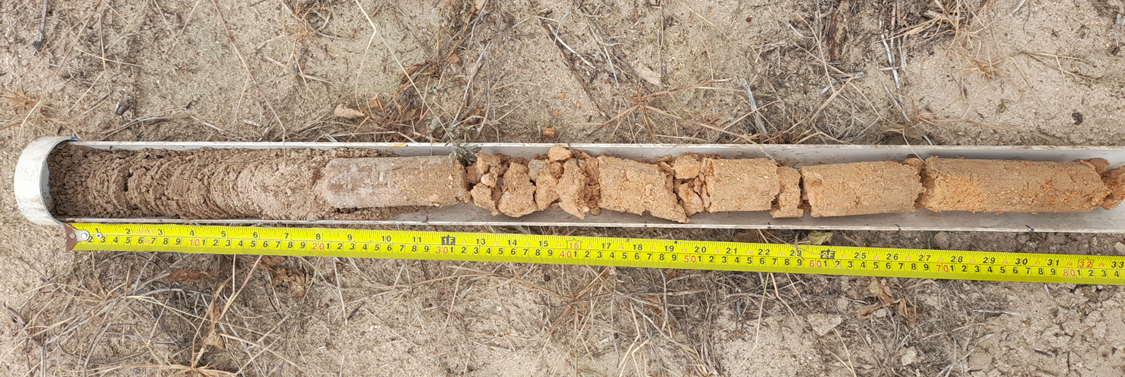
Soil profile showing sandy topsoil with clay subsoil.
Observations
Ben has noticed an increase in his productivity and profitability as a result of these practices. In 2022, a good year, wheat yields compared favourably with surrounding crops, but it has been in the run of dry seasons that the crops have really shown they are more resilient. Ben believes this is due to a combination of well set up paddocks from the legume phase and gentle nutrition to create strong plants:
“Being able to grow lentils has been quite a breakthrough and allowed me to say growing a low-yielding lentil crop with very, very low inputs, is more profitable than doing a wheat on wheat, and then going back to a legume. I might as well just go straight to the legume and then go straight back to the wheat. And that seems to be working really well, because the lentils like growing on a wheat stubble, the wheat loves growing on a lentil stubble. If we need a two year break to boost weed control, a canola can slot in between.”
Ben has also observed improved productivity in the areas that have been deep ripped. For example, in the 2022 season the deep ripped sand over clay had an average yield of about 4 t/ha compared with the unripped adjoining areas with 1.5 t/ha:
“The only fertiliser my deep ripped sand crops got was 20 litres per hectare of bio-fert at sowing and 2 foliar bioferts with a total of 30 kg per hectare of urea.They had no granular fertiliser whatsoever. They were yielding between four and five tonnes per hectare, and it was because the ripper brought up nutrients and allowed better establishment and deeper root growth. It’s not a subtle improvement. It’s the most mind-blowing dramatic improvement from doing something to the soil. I’ve never seen results so dramatic in increasing production, as deep ripping that sand. Obviously the nutrients in that clay are missing in the sand above, because where we ripped the wheat straw was like egg yolk yellow. It was just this glorious golden colour. Where it hadn’t been ripped it was grey-white colour.”
With these changes in practices, such as maintaining cover and using biofertilisers, Ben has seen an overall improvement in the resilience of his landscape, particularly with events like droughts and floods:
“We had 150 mm of rain in 24 hours this January, half of that was in about an hour. We had rivers of water 200 m wide going across our farm. At the end of the day we hardly had any damage. There were paddocks that had water flooding across them and all it did was lay all the full length straw down flat and the river flowed over the top of the anchored straw. We lost loose mulch which floated away but thankfully the soil was still there.”
“We were very fortunate, other districts on Eyre Peninsula had more than double that amount of rain in the same period which caused massive erosion. The lentil paddocks lost more mulch and lacked cover after the flooding. By seeding time in April those soils were much drier and harder than the soil under the wheat stripper straw. So whether it’s drought or floods, having cover on the soil and good soil structure improves your chances of protecting the soil and establishing crops afterwards.”
Ben believes soil health underpins this resilience.
Steve & Katrina Saunders (Northern and Yorke Peninsula)
Key Points
- Steve and Katrina are focusing on improving the health of their soil and overall farm system, in part by substituting high analysis fertilisers with alternative fertilisers, and by implementing winter cover crops for cattle grazing.
- They are keen to maximise the synergies of a mixed cropping-livestock enterprise. Recognising paddocks benefit from cropping rest periods, they will implement a standard five-year rotational cropping plan, integrated with grazing periods.
- Steve and Katrina have noticed a large increase in worms in their trial of multispecies cover crop paddocks.
Introduction
Steve and Katrina’s farm is located in the Northern and Yorke Peninsula region, between the Clare Hills and the Barunga and Hummocks ranges. On their farm, with Brown Sodosols and sandy clay loam soils, they receive an average rainfall of 400mm.
Background
Steve and Katrina have historically been farming cattle and are new to cropping. They are in the process of scaling up their cropping enterprise, and are taking an ‘all-in’ approach to changing their practices. In planning for future droughts, Steve and Katrina are increasing soil cover and increasing water infiltration to improve their overall pasture and soil health and resilience. They expect these approaches will help plants develop deeper and better root systems.
In addition, Steve and Katrina aim to increase their soil health, improve soil biodiversity and to improve the health of their herd and whole farming system. When possible, they prefer to avoid using insecticides and sprays.
Practices
To reduce their use of high-analysis fertiliser they have enjoyed making their own Johnson-Su compost, with a mix of potassium nitrate, kelp, calcium and zinc. They have also used pelletised worm castings in their cropping pastures.
Steve and Katrina have implemented a large-mob rotational grazing system where a portion of the farm is rested from cropping each year. They are working towards a standard five-year rotation plan which will rest 20% of the farm every year with a cover crop mix which can be grazed by the cattle. This rest portion is currently 10% of the farm, and as part of the Paddock Labs project they trialled a winter cover crop with a mix of seven species, including tillage radish.
Having that land put into the cover crop this year, we were able to graze it in the middle of the year, which by the middle of winter was great because it gave our hills a chance to have a rest…. and then we’ll use it again, we’ll graze it. March, April, we’ll put all the cattle in there and graze it back at the end of summer, and we’re keeping that cover on the hills for the whole of summer. So the worms and everything have an opportunity to survive the whole year.
Steve and Katrina have also been trialling volunteer beans both with their wheat crop, and following the cover crop grazing, as a way to add natural nitrogen to the soil.
We’re planting beans into [the rest paddock] next year. So, that’ll give it another hit of natural nitrogen. So we are then setting it up for a good wheat crop the year after that… But that’s probably the benefit of having livestock as well. Because even though that land has had a rest, we’ve still been able to use it for livestock. So therefore put meat on our cattle… and that’s the bonus of having a livestock/cropping enterprise rather than just cropping.
Observations
During the Paddock Labs project, Steve and Katrina made good use of the Soilmentor app to help their in-field observations, to collect photos and notes to track their progress. In the paddocks with cover cropping and rotational grazing they have observed that there are ‘a lot more worms’ in the soil, which have been lacking in the cropping paddocks.
Significantly, they have also found that by improving their soil health, they needed to apply less fungicide in the unusual wet 2022 season, which improved their overall profit margin.
Steve and Katrina’s approach to resilience is rooted in their understanding of releasing pressure on their farming system. This includes resting the soil through their five-year rotation with one year of plants like tillage radish and beans; this ensures that 20% of their farmland is not cropped every season. Additionally, incorporating livestock into their system provides them with the added benefit of reduced risk, as the cattle integration allows them to get some revenue out of the rest period, or if a crop fails in a bad season. Katrina shares that
Even though that land has had a rest [from cropping], we’ve still been able to use it for [grazing] livestock. So therefore put meat on our cattle… and that’s the bonus of having a livestock/cropping enterprise rather than just cropping.
Lastly, by reducing their spending on inputs into the system, they have reduced their overall stress and increased the resilience of their enterprise, stating that
If you’ve kept your cost down, you’re going to ride through it better than someone that’s had to throw everything at it.
With this approach, Steve and Katrina are creating a more resilient farming system that is less dependent on external factors and more self-sufficient in the face of uncertainty.
Making practical in-field observations
In addition to learning drought resilient practices, the South Australia Paddock Lab crop growers want to be able to monitor the impact for themselves.
Participants felt that generally in the agriculture sector too much emphasis is placed on scientific and agronomic results and too little on helping farmers understand how long-term soil health and resilience relates to the principles of business and increasing profits.
Specifically, the Paddock Lab participants wanted to know how different practices will affect their long-term resilience, profits and improve their bottom line. The participants believed that farmers should pay more attention to their observations and try to understand causes sooner rather than later.
Soils for Life has seen that by learning how to make their own observations with tangible and accessible science – like changes in earthworm counts, root depths and rate of water absorption over time – farmers are able to better know their landscape.
Becoming versed in their own landscape observations means crop growers can make a more informed assessment of advice and understand the long-term financial impact of the management decisions.
To support farmers in developing their own observations of changes over time – or soil and landscape health observations – the project provided each participant with access to and training on the Soilmentor app. Soilmentor is a phone-based tool that helps farmers easily record and monitor some key indicators or soil health on their farms. These data can be compared with financial data over time.
We also ran a webinar with Nicole Masters, an internationally respected agroecologist and one of the developers of the Soilmentor app. The first part of the webinar features a demonstration of Soilmentor. In the second part of the webinar, croppers share photos of how their plants were responding to the practices, and Nicole and the peer group help interpret and provide practical insights.
Another key intention for the Paddock Labs was for each farmer to reconnect with their soil and gather data that they can be in charge of and interpret themselves, which supports more informed decision-making and improves soil, landscape, productivity, financial and personal resilience in the long-term.
Upon reflection after the project, most farmers shared that they had adopted a philosophy of ‘experiment and observe’ to try to understand the cause of issues as they arose. They appreciated that different farming practices have different outcomes depending on the context of the farm and the needs of the farmers.
The participants also noticed that they had an increased trust in their ability to monitor soil and plant health through in-field observations, had more confidence in collecting visual information, and were becoming more confident to make decisions based on these observations.
Many farmers identified a sense of achievement or increased self-esteem through being able to utilise their own observations to guide decision making. In addition, farmers generally noted an ongoing enthusiasm for experimentation and observation, leading to greater appreciation for their work.
In relation to the technical support for making observations, several farmers saw great value in the Soilmentor app.
Webinar series: Nicole Masters and the Soilmentor App.
Digging deeper
If you want to learn more about the impact of the Paddock Lab process, check out the essays below. The first essay summarises how participants of the South Australia Paddock Lab felt the practices learned, and process experienced, helped to build their resilience. The second essay shares their reflections on the benefits of the Paddock Lab’s peer learning process.
Essay: Building resilience through soil health practices
The primary goal of the South Australia Paddock Labs was to build the resilience of the cropping community in the face of unpredictable weather conditions, such as drought. Reflecting on their experiences, producers shared their perceptions of improved resilience, including of their landscape, financial situation, productivity and personal wellbeing.
Landscape and soil resilience
- Soil organic matter and carbon
- Soil structure and root structures
- Soil biology
- Water storage in the soil.
Participants linked these soil health improvements specifically to increasing their drought resilience. One participant explained that:
“By increasing your soil health and ground cover and organic matter, you’re increasing your water storage in the soil and that’s going to make it more drought resilient by having that better soil condition and water stored in the soil for the drought.”
Other crop growers recognised the importance of ‘better root systems, and better coverage over the pastures’ in storing water in their landscape. Another farmer identified the role of earthworms in increasing drought resilience, noting that ‘they’re aerating the soil which makes it fluffier, which then increases your water infiltration.’
In addition, improving soil health reduced the need for inputs such as fungicides and insecticides, thus linking to financial resilience.
Soil and financial resilience through informed input choices
Farmers identified that changing practices to improve soil health led to reduced input costs, which significantly improved their overall resilience and self-sufficiency.
For some participants, input costs were seen to be more of a challenge to the resilience of their business in the future than a changing climate: ‘I actually reckon interest rates and input costs are going to be our ‘drought’ and not weather.’ Hence there is an understanding of not only focussing on drought resilience in farming, but to consider the financial resilience of the farm in a changing context.
Paddock Lab participants reduced the cost of inputs primarily by producing their own biofertilisers, or by reducing the need for inputs altogether through rotational grazing and increasing plant diversity.
For example, one participant utilises a legume or medic-pasture in rotation to ‘have a pasture system that really complements our cropping system and means that we’re more sustainable and more resilient in the way we supply nitrogen and less reliant on applying it artificially.’
Another participant uses beans and canola in their rotations and finds that ‘we are having lower inputs with the same return. That’s amazing because we’ve got more resilience.’ She now feels able to investigate different alternatives, ‘so that we can look at long term forecasts and select the right management to fit the season as much as we can. I think it builds resilience.’
A third participant – who had shifted from fertiliser to manure, with deep ripping and rotational grazing – shared ‘if a drought year comes, El Niño, we’ll still turn a profit and we’ll do it with the background knowledge that we haven’t spent the big bucks on the fertiliser by being more conservative… It’ll create a sustainable farm business.’
Participants also appreciated how their reduced inputs strengthened both financial and soil resilience. One participant explained the linkages he observes between inputs, financial risk, and soil health, particularly in relation to resilience in the face of drought and other climatic challenges:
“If you’re running a system of, well lower inputs for starters, your risk is already reduced financially. So if you…. have drought or flood or whatever disaster that occurs, which we’re seeing more of, I guess, then that’s going to assist economically. But also if you’ve got a healthier soil and microbiology that are basically working together to make nutrients, I think you’ll have a much more resilient system that can both handle those drought conditions and even potentially thrive in those conditions.”
Resilience from a gross margin perspective
Generally, farmers agreed that shifting their focus from gross yield to gross margin resulted in a more financially resilient business model.
Participants felt that crop growers commonly focus on maximising yields, because there is not a common appreciation for margins:
“Without understanding the economics of their business, people think that more is better, so they put more inputs in, try and grow more yield, trying to make more money, thinking that will make a better and bottom line… And so, if you understand margins, and you go, “Well, hang on a minute…”
By improving soil health, the participants found they were able reduce their inputs, making them less vulnerable during a challenging season (that is, they had less at risk and did not need a large yield to make a profit):
“In a perfect year, if you can grow the same amount with less inputs… then when a drought comes, you haven’t spent say $1,600 a hectare. You might have only spent $600 because that’s what you work on, or when a drought comes, if you’re only reaping a two-ton crop where are you going to cover your costs? “
Participants also discussed their mind shift to transition to a focus on gross margins, and suggested ways for other interested crop growers to think about this change in mindset: ‘If you can iron out the highs and lows just by lowering your expectations and then not going for gold each time, your business is much, much more profitable.’
Farmers acknowledged that reducing debt and expenses generally also resulted in reduced stress, with one noting that ‘you don’t want too many ducks to have to line up, and deep down that’s what causes a lot of stress for farming families and businesses.’
Resilience through reliable and high-quality produce
Crop growers also recognised the change in practices as leading to a more reliable product in the face of climate unpredictability. For example, one farmer described his change in practices as helping to mitigate the risk of low yields during drier periods, because his improved root structures help his crop to hang on through drier periods:
“A crop that’s going more steady with a big root system is more likely to hang on and make it through to that late rain that you might get. And then you’ll salvage your result out of it. So it’s definitely a significant risk management strategy, this way of farming.”
Overall, this farmer believed his practices meant his crops were benefiting: ‘relative to what other people were doing around me, I could see how much the crops were being supported by the way I was farming, just keeping the cover on the soil and not getting wind erosion.’
Crop growers also recognised the change in practices as leading to a better quality product. Farmers identified the importance of soil health and reduced chemicals in the production of crops which would have benefits for human health, with one noting that ‘if we can get actually proper mineral dense produce, well then everyone’s got to eat less… It’s better for you.’
Another participant stated that ‘to have to continue to apply more and more stuff and poisons and sell that to consumers and be able to sleep at night about that. Just basically tainted food. I’m not really that interested in doing that.’
Personal resilience
Participants also readily shared the benefits that changing their practices was having on their personal resilience, due largely to decreased financial stress, but also to increased satisfaction in the way that they were farming.
Participants spoke of the personal benefits of changing their business to focus on lower inputs and gross margins, noting that they now had ‘no stress and a lot of satisfaction.’ One participant also recognised how their decreased stress enabled them to see the possibilities when they were experiencing harsh climatic conditions: ‘I wasn’t getting stressed out about it… We saw it as a grazing opportunity.’
Even though one participant was turning over less than they did in previous years, they felt that this is more than balanced by their improved quality of life:
“Our business turns over a lot less than it used to, and our margins are even a bit less than they used to be. But you know what? Our quality of life has gone through the roof. I now love being a farmer. I now am really proud and honoured that I have the opportunity to feed the world.”
Crop growers found a sense of satisfaction with increased self-sufficiency, such as being able to create their own biofertiliser inputs. One participant, for example, reflected on how empowering they found the process:
“I’m enjoying my farming and doing what I’m doing. It’s quite empowering to be producing such a significant input and having that understanding of exactly what’s in it, how it’s made, why it works, what my soil needs and how I can match it to what I need, that.”
Another important aspect in improving personal resilience mentioned by almost all of the crop growers, was the importance of belonging to a community of like-minded people to provide support, help crowdsource answers to their questions, and not feel isolated in their goals.
Getting started in the transitions towards resilience
Many crop growers are very keen to change their practices to improve their soil, product, and financial resilience. The Paddock Lab participants are very encouraging of others doing so as well, and in offering reflection to other crop growers, they recognised the importance of making changes slowly, not least because of financial obligations:
“Most farmers would love to say we can snap our fingers and go to a lower input, more resilient and more profitable system. But they are extremely sceptical and also pretty much drowning in debt and risk already from following what the conventional methods are. So the way to bring people around is to, I guess, be able to demonstrate how you can even attempt to make that change, where you’re going to see you’re going to go through a transition period. How do you do that without going even more bankrupt?”
To begin to make the transition, they suggest that other interested crop growers not ‘jump into it overnight because they still got the bank loan, they got to keep the bank happy.’
Some farmers discussed doing this through transitioning one paddock at a time, or through trialling one practice change at a time. One farmer stated that this slow and specific experimentation and observation is important, as when you ‘do too many things at once, well you don’t know what really works then.’
Essay: Peer-to-peer learning in the South Australia Paddock Labs Project
Soil health and function are essential for all enterprises growing food and fibre. Some enterprises, such as grazing, have commonly known and established practices that promote soil health and function.
Comparatively, practices that could promote the health and function of soils under cropping are not as widely adopted. As such, there is huge potential in Australia to support crop growers who are actively interested in growing crops in ways that improve soil health and thus resilience in the face of an increasingly unpredictable climate. An important process in the South Australia Paddock Labs Project was to design and facilitate peer-to-peer learning around topics of interest and relevance to participants. These topics ranged from developing on-farm compost, to plant sap tests and foliar applications, and monitoring root health.
Reflecting on the process, the Paddock Lab participants found a great deal of benefit from being involved in the peer-to-peer learning group.
Farmer-led process
In particular, participants recognised the importance of building farmer knowledge through farmer-led processes, because it acknowledged the expertise of crop growers. One participant felt building confidence in farmer expertise was particularly important, because he saw the reliance on agronomists as causing a loss of knowledge amongst farmers:
“Less and less farmers want to be engaged in this stuff. Especially crop farmers, they’ve all got agronomists now; the agronomists tells them what to do, they do it, they go home. I think we’ve got a massive loss of education and knowledge in ag because farmers don’t need to know themselves because they have an agronomist.”
Shared interests
Learning from peers with similar interests allowed more in-depth sharing of knowledge and a sense of common purpose, which the participants felt was more likely to lead to further action.
Before the Paddock Labs, the participants did not necessarily know that farmers with shared interests were nearby. One participant reflected, ‘I wasn’t aware of other people out there doing regenerative methods, so the highlight for me was learning that there are other people out there trying to go down a more regenerative method or method of using less chemical inputs and fertilisers through understanding what they’ve got in their soil already, and to connect with them.’
Several participants also found it beneficial to be in a group of farmers with mixed cropping and grazing enterprises. For example, one participant explained how they wanted to grow their livestock business but found they couldn’t have that conversation with people who are ‘cropping-focused’ because ‘they’re interested in a different set of rules to determine success; they want to be a high-input farmer that grows more yield and not necessarily look at, “Okay, what is the best business for your patch of dirt?”’
Participants were excited about finding a group with shared interests because, ’You don’t feel so much on your own; the reality is what we are doing, you do feel like your neighbours and most people in our district think that we’re a bit loony.’ Another participant explained that the benefit of connecting over shared interests was that it translated into action:
“As soon as you get farmers together who are like-minded and who are trying to find answers to the same challenges or are trying to find answers, as soon as you get them together, you’ll find that we all really open up. It makes you far more likely to put things into action, because you know it’s a bit of a common purpose.”
Sharing successes, mistakes and questions
Participants also appreciated the opportunity for learning, which embraced the good and the ugly side of change and experimentation through sharing mistakes as well as successes.
Sharing mistakes, they felt, is a powerful way to learn. One farmer shared, ‘It was reassuring just to hear that other people were doing things different. I always reckon when you’re trying something like this, you want to hear other people’s mistakes because that’s really where we really learn.’ Another farmer echoed this sentiment, saying,
It’s good to know there’s other people that are having a crack at stuff and actually having success stories and fails. That’s what it’s all about. It’s learning what people have tried and failed so that you know that part of it is not worth worrying about.
Hearing their peers’ successes and struggles also provided reassurance to participants to continue what they were doing. They valued the opportunity to see their peers ‘having a go, and talk about their successes and talk about what hasn’t worked; that’s really helpful to help me personally to continue thinking, well this is worthwhile doing.’
They also recognised and valued that answers weren’t always straightforward, but questions could be just as important. They found it helpful to hear their peers’ questions because, ‘other people’s questions show I’m not the only one who’s struggling with that. Even if there’s no answer given, it’s validation that it’s worthwhile continuing.’
Mix of learning mediums
The farmers found it helpful to stay engaged and informed by having regular meet-ups using a variety of different in-person and online learning activities, such as field visits, webinars, and informal discussions.
They appreciated the practical and hands-on field visits as opportunities to see various farms during different seasons, learn from experts, see a range of approaches on different soil types, and learn specific skills, such as field tests for soil health. They found the field tests particularly helpful, as ‘we would all get together and talk and actually see how to do some of the soil tests.’ Attending the field days events also ‘enables connection afterwards so that you can reach out and ask questions to other farmers if needed.’
An added benefit of field visits were the informal learning, camaraderie and sense of community that came from carpooling. This allowed ‘people to have a bit more of a conversation in the car travelling’, and they felt these in-between conversations were very valuable, particularly after ‘standing in the paddock for half a day.’ On the other hand, some farmers said they would like to see more localised groups, with less travel involved and the ability to meet up locally.
Participants also appreciated that the webinars allowed them to learn not only from each other, but also from international experts in various fields, such as soil health and sap testing. Some farmers appreciated the ability to listen to recordings of live Zoom calls if they missed a session, or to relisten to something while out on the farm.
Some farmers noted that the ongoing communication, such as phone calls and semi-regular Zoom meetings kept them accountable and in the learning process. One farmer stated that ‘keeping in touch is beneficial, it keeps the group going and thinking about things’, however it was noted that these check-ins could have been more regular.
Generally, farmers did not participate in the private Facebook group, however it was suggested that a more informal tool, such as WhatsApp, might be more suitable to quickly upload and share information and photos whilst in the field, and to ask questions.
Taking the next step
Regardless of the learning activity, participants appreciated the action-oriented approach of the learning across mediums, with one farmer stating ‘You can talk about it all the time, you can read all the books, whatever, but just go and do something.’
Some farmers appreciated that the group focused on practical solutions that were proven to work, rather than being overly scientific. One farmer noted that ‘the scientists ‘scientise’ too much, whereas the farmer, we know it works, so let’s go and do it.’
On the other hand, farmers also valued the opportunity to learn from other farmers and experts in order to understand the reasons behind the solutions and how to take the next step in their farming practices. For example, another farmer enjoyed being able to choose their own direction and have access to ‘the researchers, or the scientists, or the whatever, here to help us understand why it’s working.’
The participants reiterated it was important to be open to trying new things and to learn from observations, as well as gain an understanding of the long-term impacts. In addition, the farmers generally appreciated that the techniques, and the success of the techniques, will vary based on the location and context of the farm, and the needs of the farmers.
Ultimately, the farmers felt that the benefit of having a community of like-minded peers is that they could encourage and support each other over time, as they continued taking steps forward. As one farmer said, ‘We don’t want to be saying, “You got to change, you got to change, you got to do this and that,” but to encourage each other to take small steps over time, it’s a process over a few years.’
Video gallery
As part of the South Australia Paddock Labs project, Soils for Life hosted a series of three webinars together with farmers and scientists. Explore the different topics below.
Making practical in-field observations. Nicole Masters and the Soilmentor App.
To support farmers in developing their own observations of changes over time – or soil and landscape health observations – the project provided each participant with access to and training on the Soilmentor app. Soilmentor is a phone-based tool that helps farmers easily record and monitor some key indicators or soil health on their farms. These data can be compared with financial data over time.
We also ran a webinar with Nicole Masters, an internationally respected agroecologist and one of the developers of the Soilmentor app. The first part of the webinar features a demonstration of Soilmentor. In the second part of the webinar, croppers share photos of how their plants were responding to the practices, and Nicole and the peer group help interpret and provide practical insights.
Find out more about this webinar here
Sap testing with Mark Tupman, a horticulturalist from Productive Ecology.
Sap testing is an emerging practice, where farmers are measuring the sap in plants for indicators of current nutrition, such as total sugars, potassium, calcium, magnesium, sodium, ammonium, nitrogen, etc.
Two farms implemented a sap analysis program, with four demonstration sites on Eyre Peninsula also having some exploratory analyses conducted. Most of the participants used visual tests to determine the health of the crops and soil.
As part of the Paddock Labs project, Soils for Life hosted a webinar on sap testing with Mark Tupman, a horticulturalist from Productive Ecology. Because sap testing is quite technical, expert advice is often recommended.
Find out more about this webinar here
Trials with Alternative Fertilisers with Tom Robinson and David Foster.
Towards the end of the Paddock Labs process, we hosted a peer learning session, where two focus farmers shared their experiences and lessons with alternative fertilisers.
Tom Robinson shares and answers other farmers’ questions about his experiments with summer crops and grazing, seed coatings, sap testing and foliars, and crop nutrition management. He also shares a video of his set up for coating his seeds with Johnson Su fertiliser and then transferring to the truck.
David Foster shares the design and results of his replicated trials with deeping ripping, companion planting with alternative fertilisers, such as manures, and what he calls synergy planting. He talks about the benefits of sowing wheat and beans and sweat corn and beans together, including a ‘doubling of root mass’ and nitrogen deficiencies where the beans weren’t included.
Find out more about this webinar here
More information
To find out more information about South Australia Paddock Labs, reach out to: [email protected]
And engage with us on social media for the latest information, events and images:
Project Partners
Australian Government
Soils for Life
Davenport Soil Consulting




